Commemorative postage stamps Program
Novi Sad – European Capital of Culture



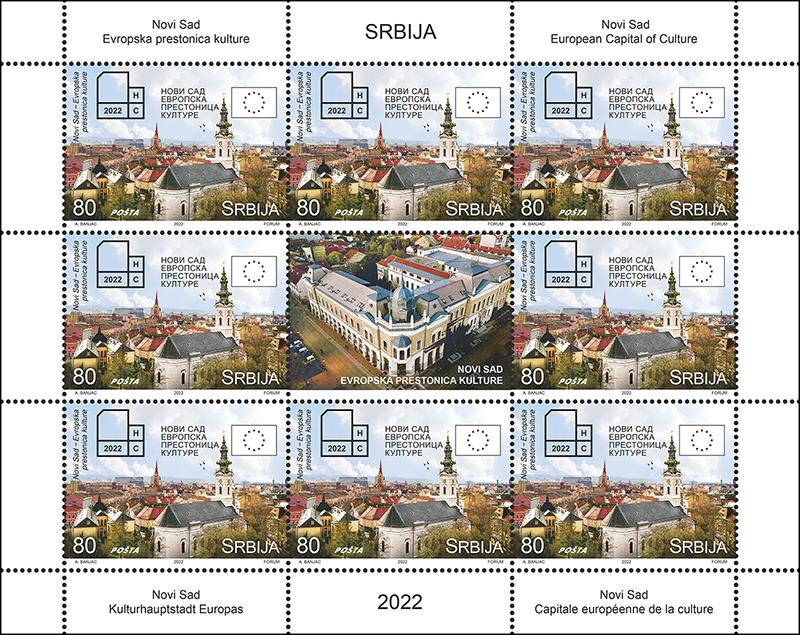



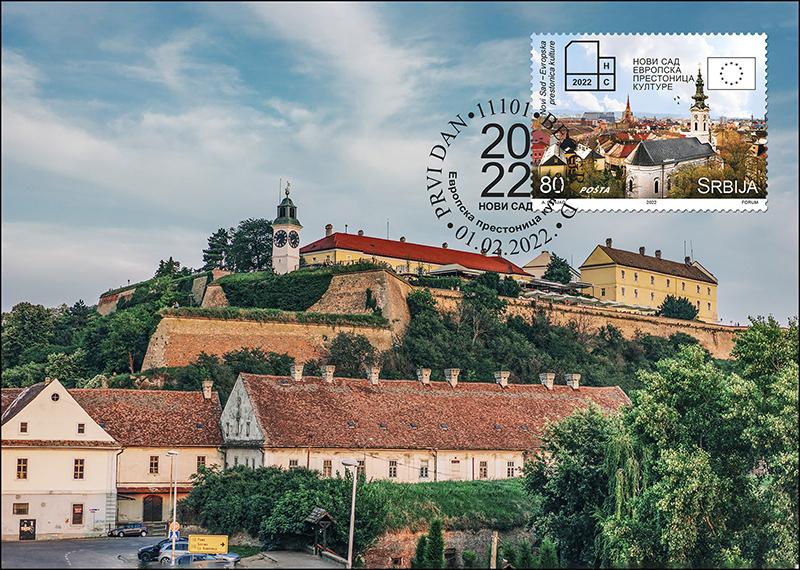

Novi Sad is the European Capital of Culture for 2022.
It’s one of the first cities outside the European Union to bear this prestigious title.
The programme concept is based on the slogan For New Bridges, which addresses the idea of connecting people, programmes, processes and spaces, thus positioning Novi Sad on the European cultural map. This is how The Beginning of New. Now! project’s vision was put into practice.
Our programme arches thematize different relevant cultural and social issues, nurturing interculturality and other European values as an important part of Novi Sad’s identity. Visit our events and become part of the European Capital of Culture.
Welcome!
Expert collaboration: Foundation “Novi Sad − European Capital of Culture”; Photos: Jelena Ivanović and Vladimir Veličković.
Graphic design of the issue: MA Anamari Banjac, Academic Painter
FEST´s 50
When FEST hopefully turns 100 years, I doubt anyone will use telegrams and postage stamps. That is why this special and collectable edition of the Post of Serbia will have philatelic value one day, as a trace of our festival and time.
The slogan of the jubilee 50th FEST is NEW.BRAVE.WORLD, almost an anagram of the first one, which read BRAVE NEW WORLD as the novel of Aldous Huxley. Humanity has changed in the last half century. Geopolitically, technologically, economically, health-wise... Some inventions and phenomena that surround us are better and make life easier, some worse because they make it harder and faster, but man at the beginning and end, of both good and bad film, always finds a way.
World that surrounds us, will be new after Corona, and for it we shall need courage to fight, for ideas and survival.
What is true for an individual is also true for a group, in this case an international film festival. Belgrade FEST has become the majority owner of its existence and is now raising the curtain and starting the further projection towards its first century. The path more travelled is paved with the films that have been shown at FEST so far, the emotions they inspired, the memories they wrote down for us. Upon us are films that have yet to be made, and above all, challenges that sometimes even a film cannot predict.
Let us be brave and capable for a new world and a new FEST in it!
For another fifty years, for another round!
Expert collaboration: Ivan Karl, Secretary for culture of the City of Belgrade, President of the Fest Board. Graphic realization of the issue: Nadežda Skočajić, academic graphic artist
XXIV Winter Olympic Games – Beijing 2022






From the first Olympic Games of the modern age, held in 1896, to today,s XXIV Games of the Winter Olympics, this sporting event is the largest international sports competition of our era. Under the motto Citius, altius, fortius – faster, higher, stronger, athletes from all over the planet are competing for victories and the shiniest medals in their disciplines.
The modern Winter Olympics have been held since 1924, when the French town of Chamonix hosted the Winter Sports Week under the auspices of the International Olympic Committee. This event, later renamed the first Winter Olympic Games, was a great success and attracted great interest of the audience.
The XXIV Winter Olympic Games will be held from February 4 to 20, 2022 in Beijing, the capital of China. Beijing is the first city in the history of the Olympic movement to host both the Summer and Winter Olympics. Beijing hosted the 2008 Summer Olympics, and was chosen to host the Winter Olympics at the IOC session on July 31, 2015. This will be the third edition of the Olympic Games in a row in Asia, after PyeongChang 2018 and Tokyo 2020.
The Winter Olympic Games in Beijing are also the first Winter Games to be held in the conditions of the Covid-19 virus pandemic, and, as a result, they will be held in specific conditions and without the presence of foreign spectators in the stands. Holding these Games, however, will be a clear signal that life is stronger than all adversity.
The mascot of the Beijing Winter Olympics will be a panda made entirely of ice called “Bing Dwen Dwen”. “Bing” in the Mandarin dialect of Chinese has multiple meanings, but is most often related to ice, while “Dwen Dwen” means robust and lively, but also means children.
The Serbian team will be composed of the best athletes currently coming from the group of winter sports, who will compete primarily in ski disciplines.
Expert collaboration: Olympic Committee of Serbia.
Artistic realization of the issue: MA Nadežda Skočajić, Academic Graphic Artist
Statehood Day – Indivisible Serbia




In 1804, on the day when winter and spring meet – the Meeting of Our Lord, in the Marićević Gully, Serbia made its first, big step on a two-century journey towards freedom and statehood. On the same day in 1835 during the Sretenje Assembly, Serbia confirmed its statehood by adopting the highest legal document − The Constitution of the Principality of Serbia, one of the most modern and democratic constitutions of that era, the first constitution of the modern Serbian state.
The key events for the creation of modern Serbia are embodied in two most important historical figures of that era, Karađorđe and Miloš Obrenović, who each in his capacity personify the warrior spirit and readiness to win freedom and independence through the use of arms, i.e. the skill to preserve the hard gained freedom and to defend the young state that was still in the making through political and diplomatic activities.
The two-centuries history of modern Serbia is an intertwined and closely connected relationship between these two principles, in accordance with historical circumstances and statesmanship reasoning. Behind both of these principles is a firm intention and determination to preserve state integrity in modern times, despite all the temptations that Serbia has faced or is facing today, which is best reflected in the fact that the Republic of Serbia is today a full and respected member of the United Nations.
15 February is celebrated in Serbia as the Statehood day and as the Day of the Serbian Constitution.
Artistic realization of the issue: Vukašin Marković, graphic designer
100 years of NIP “Borba”




The Newspaper Publishing Company “Borba”, with a full century of existence behind it, has been a pillar of culture and the cradle of Yugoslav and Serbian journalism since its inception. “Borba” was first published in Zagreb in 1922 and was published regularly, as a weekly, until January 13, 1929, when, after the introduction of the 6 January Dictatorship, it was banned. It started publishing regularly again, under the old name, during the Second World War, in liberated Užice, where it was printed until November 27, 1942. Immediately after the liberation of Belgrade, in the war year of 1944, on November 15, in the “Borba” Printing House, the first Cyrillic issue of the newspaper bearing the same name was published, and NPC “Borba” found its permanent residence in the building on Nikola Pašić Square no. 7, where it has been situated for almost eight decades.
Apart from the newspaper “Borba”, the “Borba” Publishing House was the initiator of dozens of printed editions, from “Kekec”, through “Sport”, “Ekonomska politika”, “Nada” ... to “Večernje novosti”. A group of journalists from the daily “Borba” started the radio station “Studio B” in the building on Nikola Pašić Square no. 7, and the first play of the famous “Atelje 212” theatre was played in the building of “Borba”. Some of the greatest and most respected authors of Serbian literature have enriched the history of the guardians of the tradition almost 100 years long, with their writing and reporting.
“Borba” has worked hard for years to preserve all documents and photographs that tell the tale of our interesting history, and today it can be very proud of its archive, which contains a priceless wealth of texts, testimonies and photographs of an entire era.
The former daily newspaper “Borba” is today a magazine about culture, and the young editorial board, eager for affirmation, research and work, successfully leads its struggle in the print media recognizable by its five red letters, nurturing culture, tradition and Cyrillic alphabet.
Motif on the stamp: NIP “Borbа” building, drawing by Natalija Kunić. Motif on the FDC: four typical cover pages of “Borba” from different periods of publishing this daily newspaper.
Professional Cooperation: The Newspaper Publishing Company “Borba”
Graphic design of the issue: MA Anamari Banjac, Academic Painter
115th Anniversary of the birth of Petar Lubarda





Petar Lubarda (Ljubotinj, near Cetinje, 27 July 1907 – Belgrade, 13 February 1974) in the autobiographical data he left about himself in 1972, he writes: “Born on 27 VII 1907 in Ljubotinj, Montenegro, of Serbian nationality. Father: Đuro P. Lubarda, mother: Marija M. Vujković. Attended elementary school in Ljubotinj, Cetinje and Herceg Novi. Attended High school in Herceg Novi, Split, Sinj and Nikšić. Came to Belgrade in 1925 and enrolled in the Art School. His professors were Beta Vukanović, Ljuba Ivanović and Ilija Šobajić. In 1926 he went to Paris, in 1927 he exhibited for the first time at the Independent Salon in Paris. In 1929 in Rome he had his first independent exhibition in Casa d’arte Bragaglia. Same year he returned to Paris. In 1932, he came to Belgrade and organized a solo exhibition at the Warrior’s Home. Since then, he has lived in Belgrade with short or long breaks.” The text is available as a photograph within the permanent exhibition of the Legacy of Petar Lubarda.
Commemorative postage stamps issue “115th Anniversary of the birth of Petar Lubarda” dedicated to the one of our greatest artists, and realized in full glory thanks to the benevolence of the owners of the hitherto little-known works of Petar Lubarda, which were provided free of charge for presentation to the public through this issue. Ten art works by Petar Lubarda, perpetuated on the elements of this issue, remain as a lasting memory in the history of a painting greatness and unquestionable world talent of one of the most important painters from this region.
Motives: first stamp – BULL (oil and varnishes on hardboard, 65x136,5cm, around 1969); second stamp – DRAGONS (oil and varnishes on hardboard, 54,3x91,9cm, 1967); first vignette – THE VILLAGE OF BRAJIĆI (tempera on cardboard, 50x66cm, 1949); second and third vignette – SCORPION (oil and varnishes on hardboard, 30,5x79,5cm, 1969); fourth vignette – BATTLE OF KOSOVO (tempera on paper, 34x51,8cm, 1954); fifth vignette – CAMP STILL LIFE (oil on canvas, 78x77,3cm, 1942); sixth vignette – THE WAY OF FREEDOM (SUTJESKA) (oil on canvas, 74x81,5cm, 1945); seventh vignette – MINOTAUR (varnishes on hardboard, 81x100cm, 1972); eight vignette – ROCKS (varnishes on hardboard, 41x43 cm, 1960); on the cover– BLACK PANTHER (varnishes on hardboard, 60x77cm, 1972).
Graphic realization of the issue: Nadežda Skočajić, academic graphic artist
Technical details
24. фебруар 2022.
Уметничка обрада: Надежда Скочајић
1131. 30,00 дин (вишебојна) 25.000
1132. 30,00 дин (вишебојна) 25.000
Табак: 8
На коверту са жигом ПД (FDC)
Нацрти: 1131. БИК (уље и лакови на лесониту, 65×136,5цм, око 1969); 1132. ЗМАЈЕВИ (уље и лакови на лесониту, 54,3×91,9цм, 1967).
Величина мараке: 42 x 34,8 мм
Важe неограничено.
Women’s Day





International Women’s Day is an international holiday celebrating the economic, political and social achievements of women. It was first celebrated in the United States on 28 February 1909, but the following year, at the first International Conference of Women in Copenhagen, at the initiative of Clara Zetkin, it was decided to celebrate International Women’s Day on 8 March, in memory of the protests of female workers in the textile industry held in New York in 1857.
As International Women’s Day, 8 March was first officially celebrated in 1911 by more than a million people in Austria, Denmark, Germany and Switzerland. The first celebration of Women’s Day in Serbia was organised in Belgrade in 1914.
In the early 1970s, the United Nations officially declared 8 March International Women’s Day, and today it is celebrated around the world, and in more than 55 countries it is an official national holiday. In Serbia, this day is celebrated as an official holiday since the end of the Second World War. The established practice and customs of celebrating Women’s Day around the world are similar – it is a day when women are given special attention, given flowers and gifts and congratulated on their day. However, Women’s Day is much more than that – recognition of all women for their social, scientific, political, creative, sports and all other personal achievements, encouragement and support to do even more to promote women’s rights and fight for full equality.
Our society is committed to Women’s Day retaining its true meaning and conducting a continuous struggle for full respect for women and their equality in all areas.
Artistic realization of the issue: Zamurović Brothers
Joint issue of Serbia and Morocco: 65th Anniversary of diplomatic relations






Diplomatic relations between the Republic of Serbia and the Kingdom of Morocco were established on 2 March, 1957. Bilateral relations between the two friendly countries have always been on an upward path, and the friendship between the two countries is at an all-time high today, but interrelations continue to develop successfully with mutual respect and appreciation and deepening political dialogue.
Successful diplomatic relations between the two countries have been supported by significant improvements in trade relations with a tendency to further intensify them. The Republic of Serbia and the Kingdom of Morocco are well on their way to achieving a strategic partnership in all areas of common interest, and the joint issue of Serbian and Moroccan postage stamps is a contribution of the Post of Serbia and the Postal Administration of Morocco to improving and deepening relations between the two countries.
Motifs on stamps:
The New Road-Railway Bridge over the Danube in Novi Sad it was built in 2018, 474 m long and 31.60 m wide. This bridge is one of the most important infrastructure facilities on the international railway corridor and an important part of the road traffic infrastructure of the Republic of Serbia. Cable-stayed Mohammed VI Bridge VI in Rabat: Opened in 2016, the Mohammed VI Bridge is the largest cable-stayed bridge in Africa, with the tallest concrete and steel viaduct in the world. It is a bypass around Rabat, the capital of Morocco, crossing the Buregreg River at the level of the Sidi Mohamed Ben Abdel Dam. With its 942 m length, the Mohammed VI bridge at both entrances has two pylons with doubled arches, which symbolize the new gates of the cities of Rabat and Sale. It is also equipped with surveillance cameras for face recognition for security, and specific lighting that provides a surprising night visual impression.
Motifs on the envelope:
The ”Vrla” bridge on Corridor 10 near Vladičin Han, opened to traffic in 2018. With a total length of 644.4 metres, it is the longest bridge on one of the largest pan-European traffic corridors and represents an important symbol and architectural achievement of the modern road infrastructure of the Republic of Serbia. In the background Cable-stayed Mohammed VI Bridge VI in Rabat.
Artistic realization of the stamp with the motif of the New Road-Railway Bridge in Novi Sad and of the envelopes motifs: Miroslav Nikolić;
Artistic realization of the stamp with the motif of the Cable-stayed Mohammed VI Bridge in Rabat: Said Azarkan
85th Anniversary of the magazine “STUDENT”




On March 15, 1937, at the initiative of Ivo Lola Ribar, the magazine Student, a circular of the Action Board of Professional Student Associations of the University of Belgrade and the newsletter of the revolutionary student movement, started being published in Belgrade.
Student magazine, like the student movement, advocated: anti-war policy and active resistance to the ruling regime and its policy of internal terror and loyalty to Hitler’s Germany and Mussolini’s Italy; defense of academic freedoms and university autonomy; developing student solidarity and economic self-help networks; support to student cultural, sports and other associations.
As early as 1946, Student was renewed as a weekly, with content focused not only on academic topics, but also on social, political and cultural issues. Since 1968, it has played a significant role in raising graphic culture, design, comics and illustration.
Излазио је континуирано у штампаном облику све до краја XX и почетком XXI века, да би 2011. прерастао у електронско онлајн издање. Као активни чиниоци југословенске и српске друштвене, културне, политичке, уметничке, научне, новинарске и сваке друге историје, генерације „Студентових” уредника и сарадника оставиле су неизбрисив траг и подстицајно наслеђе. Повезује их чврсто уверење да је другачији, бољи, слободнији и људскији свет могућ и да се за њега вреди борити. Међу њима су: Иво Лола Рибар, Богдан Пешић, Мухамед Мусић, Милан Вукос, Слободан Селенић, Душан Макавејев, Југ Гризељ, Данило Киш, Лазар Стојановић, Ђорђије Вуковић, Бранка Оташевић, Александар Илић, Илија Мољковић, Ненад Чонкић, Миљенко Жуборски, Бранка Криловић, Ратка Марић, Мила Коругић, Мирослав Јосић Вишњић, Зоран Станојевић, Јелица Стојанчић, Зоран Петровић- Пироћанац, Саша Марковић Микроб…
Expert coollaboration: magazine “Student”. Artistic realization of the issue: MA Jakša Vlahović, academic graphic artist
140th anniversary of friendship between Serbia and Japan




This year Serbia and Japan are marking the 140th anniversary of their friendship. Serbia was proclaimed a kingdom on March 6, 1882, and the first king of Serbia after the Nemanjić era, Milan Obrenović, sent messages to the rulers of many countries around the world, informing them about the restoration of Serbian statehood. Such a message was also sent to Imperial Tokyo, from where the answer of the Japanese Emperor Meiji arrived. The exchange of messages between the two sovereigns practically represents the beginning of bilateral contacts between the two countries.
In the first half of the 20th century, significant visits were made from Japan to Serbia, including representatives of the Japanese royal family, and the first trade agreement was signed in 1923. Friendly relations were renewed in 1952 when diplomatic missions of the two countries were opened in both Tokyo and Belgrade. The second half of the 20th century was marked by the visits of President Josip Broz Tito to Japan in 1968, Crown Prince Akihito to Belgrade in 1976 and Prime Minister of Japan Nakasone in 1987. In recent years, Japanese Prime Minister Shinzo Abe visited Belgrade in January 2018 and the Prime Minister of the Republic of Serbia, Ana Brnabić, attended the enthronement of Emperor Naruhito in October 2019 in Tokyo.
Contemporary bilateral relations between Serbia and Japan are constantly rising not only in terms of political dialogue but also in economic and other areas, with the presence of Japanese companies in our market, significant investment projects, and the opening of new perspectives for further cooperation. Serbs and Japanese were with each other even in difficult times, they nurture great mutual respect, kindness, solidarity, and interest in getting to know the cultural and historical heritage and traditions.
The motif on the stamp: portraits of King Milan I Obrenović and Japanese Emperor Meiji; details of their letters in the background. The motif on the cover: details of the diplomatic correspondence of the King of Serbia Milan Obrenović and Japanese Emperor Meiji in 1882.
Artistic realization of the issue: Nadežda Skočajić, academic graphic artist
Nikola Tesla – brilliant mind of Serbian people






Nikola Tesla (Smiljan, July 10, 1856 - New York, January 7, 1943), a scientist of Serbian origin, inventor, engineer and futurist, is one of the most brilliant minds of the mankind.
He worked and created in America, but he always proudly pointed out his origins. During his visit to Belgrade on June 2. 1892, he was greeted with the highest honors and met with the Serbian king and the highest Serbian officials. Nikola Tesla was awarded the Royal Order of Saint Sava II degree. During his stay in Belgrade and Serbia, Nikola Tesla received great respect and admiration as a young and famous scientist of Serbian origin who raised the reputation of the entire Serbian people with his knowledge and works. Tesla’s visit to the Serbian capital significantly influenced Serbia to be one of the first countries in Europe to start electrification of the country based on Tesla’s polyphase system with the construction of a hydroelectric power plant in the city of Užice in 1900, just four years after the commissioning of the world’s first hydroelectric power plant on the Niagara River.
For 70 years Nikola Tesla Museum is preserving the whole legacy of the famous scientist who “lightened“ the world and gave a crucial contribution to the civilizational shift known as the Second Industrial Revolution. Extremely valuable collections of archives, books and magazines, technical and personal items, photographs, plans, and technical drawings are kept in Belgrade at Tesla’s request and they cherish the memory of the most important scientist of Serbian origin.
Thanks to the legacy entrusted to Serbia by Tesla’s nephew and successor Sava Kosanović, many people who visit the Nikola Tesla Museum in Belgrade have the opportunity to be inspired by Tesla’s work and study his inventions and see the incredible contribution that this member of our nation has made to global progress of humanity.
Expert collaboration: Nikola Tesla Museum
Artistic realization of the issue: Boban Savić MA, academic painter
Easter






Easter is one of the most important Christian holidays, “the holiday above all other holidays”. It is celebrated in the memory of the victory of Lord Jesus Christ over death by resurrection, which was announced by angels and myrrh-bearing women, finding the tomb empty three days after Jesus was crucified and died on the cross on the hill Golgotha above Jerusalem.
It is also called ‘’Christian Pascha’’, after the Old Testament holiday of the Jews, in the memory of the liberation from Egyptian slavery. For Orthodox, Easter is preceded by a seven-week fast, more rigorous than other fasts during the year. The last week of the fast is called Holy Week, i.e. Passion Week, marking the days of the passion of Christ. Many folk customs are associated with this week, including the painting of eggs, which are the symbol of the resurrection. The first painted red egg is stored until next year and is called “the guardian of the house”. At the dawn of Easter, the faithful gather in the church, greeting each other with: “Christ is Risen – Truly He is Risen!” and participate in the festive Liturgy with the priests.
Easter is a holiday of joy and faith in eternal life. The whole week after Easter is called Bright Week, and Monday and Tuesday are marked as Easter Monday and Easter Tuesday.
Easter is a movable holiday which is celebrated on a different date every year. It is celebrated between April 4 and May 8 according to the new, Gregorian calendar, i.e. between March 22 and April 25, according to the old, Julian calendar, but it is tied exclusively to Sunday. The celebration of Easter was established by a Decree at the First Council of Nicaea in 325 AD.
Тропар Васкрсења Христовог: „Христос васкрсе из мртвих, смрћу смрт разруши, а онима који су у гробовима, живот дарова“. Кондак: „Иако си у гроб сишао, Бесмртни, уништио си адову моћ и васкрсао си као Победилац, Христе Боже. Женама мироносицама си рекао: Радујте се! Твојим апостолима дарујеш мир, а палима васкрсење“.
Motifs on the stamps and on the envelope: Christ carries the cross and Resurrection, academician Nikolay Mukhin, mosaics from St. Sava Cathedral in Belgrade. Expert collaboration: Bishop Stefan Šarić of Remesiana, Vicar of His Holiness Serbian Patriarch Porfirije
Graphic realization of the issue: Nadežda Skočajić, academic graphic designer
Flora






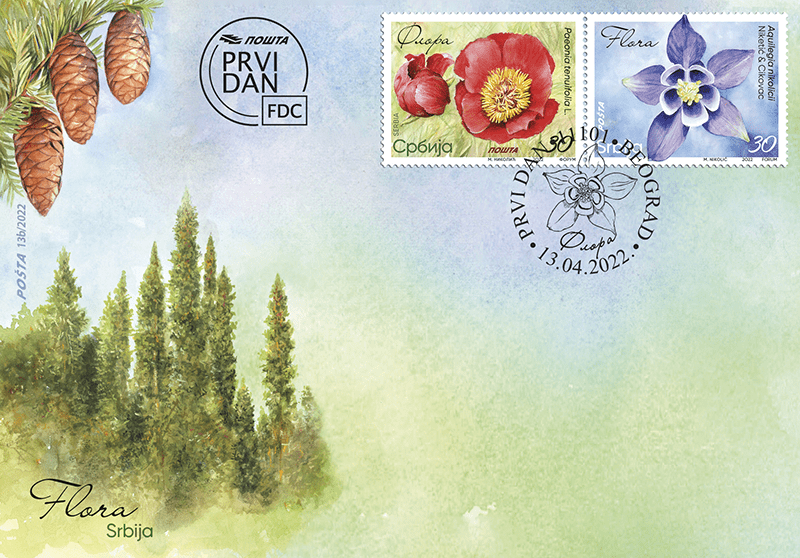

Pulsatilla grandis Wender. (Ranunculaceae) – Greater Pasque Flower
Perennial herbaceous plant, with dense silvery patent hairs and solitary large flowers. It has about ten basal leaves, crowded at the base in a rosette, three to four times pinnately divided, with (20)40–90 lobes. The flowers are 5.5–8.5 cm in diameter, cup-shaped; pedicels are erect or later slightly bent. It also has six sepals, lavender to lilac-purple, covered with adjacent silky hairs on the outside. Numerous anthers are half shorter than the petals. The fruits are collected at the top of the pedicels, with 3.5–5 cm long, silky hairy styles, which is why they are also popularly called cat’s mustache.
As a steppe relic, it appears in Serbia only on the sunny slopes of Mt Fruška Gora, on pastures, meadows, near the bushes and in post-fire vegetation. It blooms in March and April along with the leafing of trees. It is strictly protected and in the last 50 years it has disappeared from more than half of the sites, due to the overgrown habitats and picking of decorative flowers.
Adonis vernalis L. (Ranunculaceae) – Pheasant’s Eye
Perennial, herbaceous plant from the buttercup family, 10–40 cm high. In the ground it forms a well-developed rhizome from which arise glabrous stems that can be simple or branched. The leaves of the stem are sessile, glabrous or sparsely hairy, 2-4 times pinnately divided. The flowers are single, large, 3–7 cm in diameter with many yellow petals. The fruits are densely packed, with a hooked beak. It is a poisonous plant. It was once used in the treatment of diseases of the cardiovascular system, as a cardiotonic and strong diuretic.
As a steppe relic, with its large and bright yellow flowers during the spring months (April and May) it adorns dry meadows and steppes, the edges of xerophilous forests, but also some bright deciduous forests, as well as xerophilous rocky landscapes. In Serbia, the distribution of this species is related to the lowland and hilly regions of Vojvodina, eastern and north-eastern Serbia. In the past, it was far more widespread than it is today. It is a strictly protected species in Serbia.
Paeonia tenuifolia L. (Paeoniaceae) – Fernleaf Peony
The fernleaf peony belongs to the peony family. The genus name (Paeonia) comes from the Greek god of medicine, Peon. Perennial, herbaceous plant up to 70 cm high. In the ground it forms a developed tuberous root from which above-ground shoots emerge, which they grow in tufts. The leaves are green, glabrous, and divided into very narrow linear leaflets. The flowers are arranged terminally, single, large and red. The anthers are numerous and intensely yellow. The fruits are hairy follicles. The seeds are large and overgrown with white arilus. It blooms in spring (April and May). lt is a poisonous plant and can cause inflammation of the intestinal and gastric mucosa when taken orally.
This species of peony is a relatively rare plant in Serbia, and can be found in Vojvodina (Banat) and eastern Serbia. It is a steppe relic and grows within meadow-steppe communities and pastures, in dry, warm and sandy places, up to 1300 m above sea level. It is a strictly protected species in Serbia.
Aquilegia nikolicii Niketić & Cikovac (Ranunculaceae) – Nikolić’s Chandelier
Perennial herbaceous plant up to 50(–80) cm tall. The leaves are bipartite, sticky glandular or finely hairy on both sides, rarely glabrous on the surface. Petioles have numerous patent hairs. The flowers are solitary, large, with five broad flattened and nodding dark purple outer petals, 40 (-60) mm long. The inner circle of the perianth is formed by five obliquely placed leaves transformed into funnel-shaped nectars, which in the upper part spread into 15–19 mm long upright spurs curved at the top. The fruit is a dry follicles dehiscing by inner suture.
It was described as a new species for science in 2013 from the Drina canyon at the foot of Mt Tara Planina in western Serbia. This relict and endemic plant can be found only in a few more gorges in western Serbia and Montenegro, where it grows in limestone rocks crevices in wet and shady places. It is strictly protected in Serbia. It is most easily distinguished from ordinary cultivated chandeliers by its strikingly two-colored flowers.
Expert collaboration: Marjan Niketić, PhD Museum advisor and corresponding member of SANU, Natural History Museum in Belgrade and Uroš Buzurović, PhD Curator and research associate, Natural History Museum in Belgrade
Artistic realization of the issue: Miroslav Nikolić
BC “Partizan” – 30 years since winning European Champions Cup

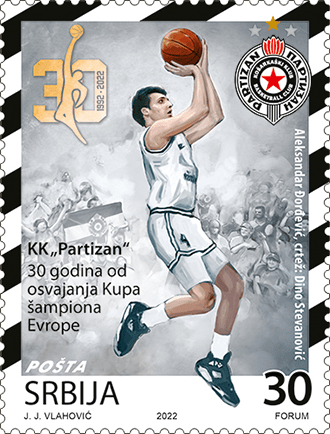


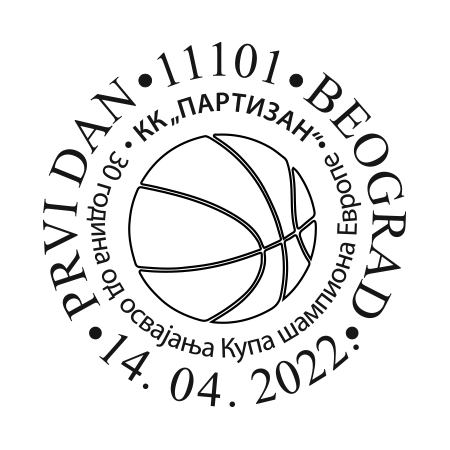
Basketball club “Partizan” from Belgrade, was founded in 1945. This Serbian club has won the national championship twenty-one times, the national cup sixteen times, the Adriatic League six times and the Adriatic League Super Cup once.
BC “Partizan” won the European Champions Cup in 1992, with Aleksandar Đorđević scoring three points in the last second of the game against Juventud from Badalona. This April, three decades after the greatest success of Serbian club basketball, the best coach of Europe, Željko Obradović, returned to the position of coach of BC “Partizan”, who already conquer Europe in his first season on the Partizan bench. In addition to that success in European competitions, BC “Partizan” won the Radivoje Korać Cup three times (1978, 1979 and 1989) and participated in the final four of the Euroleague.
In the sports calendar of all Partizan fans, 16 April 1992 is a very important, if not the most important date - the day when the Basketball Club “Partizan” conquered Europe. Everyone who has black and white in their hearts with the deepest emotions remembers the match against Juventud and the famous three points of Đorđević, thus engraving the name of our club in eternity. The team that then reached the “roof of Europe” was led by coach Željko Obradović. And now, 30 years later, the black and white crew is again led by Obradović - the most trophy-winning coach in Europe and the pride of the Partizan family.
Motifs on the stamps: Željko Obradović and Aleksandar Đorđević, motifs on the envelope: Predrag Danilović and Aleksandar Nikolić
Drawings by Dino Stevanović
Expert collaboration: BC Partizan NIS Belgrade
Graphic realisation of the issue: MA Jakša Vlahović, academic graphic artist
SERBIAN ARMY DAY




The date of the beginning of the Second Serbian Uprising, Palm Sunday according to the old calendar, i.e. 23 April, 1815, according to the new calendar, is marked as the Serbian Army Day. That date represents a historical turning point that led to the creation of a modern Serbian state and enabled the creation of an efficient and modern Serbian army. The uprising, whose leader was Prince Miloš Obrenović, was officially proclaimed at the meeting of dukes and priests in Takovo near Gornji Milanovac. It represents a successful military segment of Serbian history after which the process began by which Serbia conquered one element of statehood at a time and finally got rid of the supreme Turkish government. One of the first steps in that direction was the creation of a standing army in 1825, from 1,147 young men divided into twelve troops, who were given the name «enrolled cops». As the introduction of the standing army went unnoticed by Porta, the National Assembly made the name «soldiers» official instead of «registrar». This, standing army, lived in barracks and received a salary.
From 1850, the training of officers in Serbia began, with the opening of the Artillery School, and from 1861, in addition to the small standing army that forms its professional core, the Serbian military organisation was strengthened by formalising general military service and organising a militia-type people’s army. Through military and diplomatic efforts, Serbia gained state independence and expansion in the south at the Berlin Congress after the Serbian-Turkish wars of 1876-1878. With the military reforms that began in the 1980s, under the patronage of King Milan Obrenović, Serbia created a superior military organisation following the most modern foreign models, but also its own experience. That army showed its strength and efficiency in the wars of 1912-1918, when it became the main instrument of state policy for the realisation of the national programme of unification of Serbs and other South Slavs.
Motif on the stamp: King Alexander during the handing over of regimental flags at Banjica
Motif on the vignette: St. George’s Day Reveille on Corfu in 1916
Motif on the envelope: Parade of the Serbian army in Paris, July 14, 1919
Expert collaboration: Military Museum of the Directorate for Tradition, Standard and Veterans of the Sector for Human Resources of the Ministry of Defence; Col. Dalibor Denda, PhD, Institute for Strategic Research of the University of Defence
Graphic realisation of the issue: MA Jakša Vlahović, academic graphic artist
Institutions in Serbia

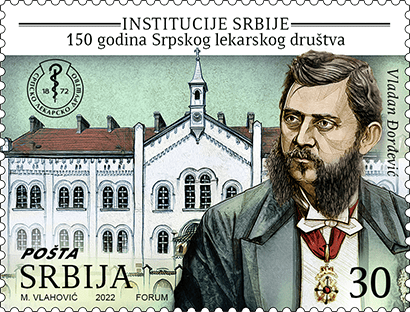
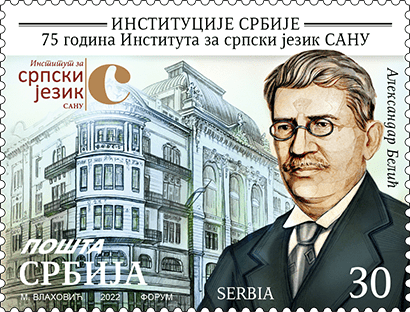







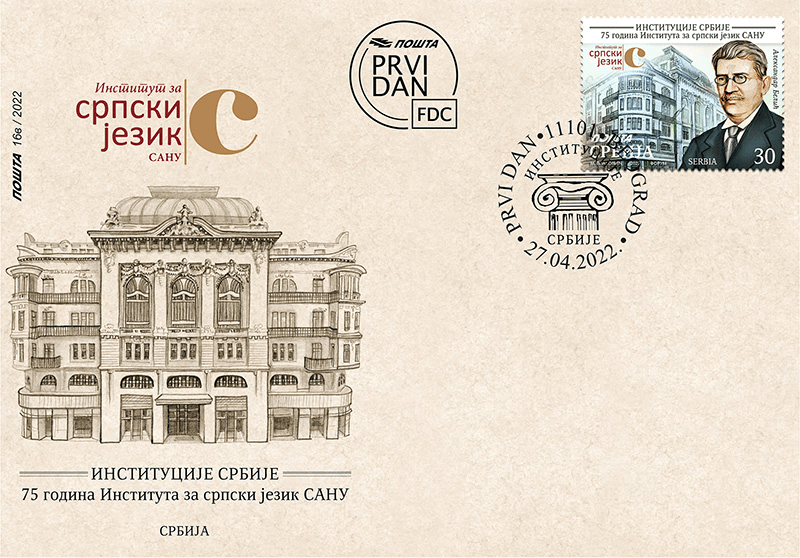
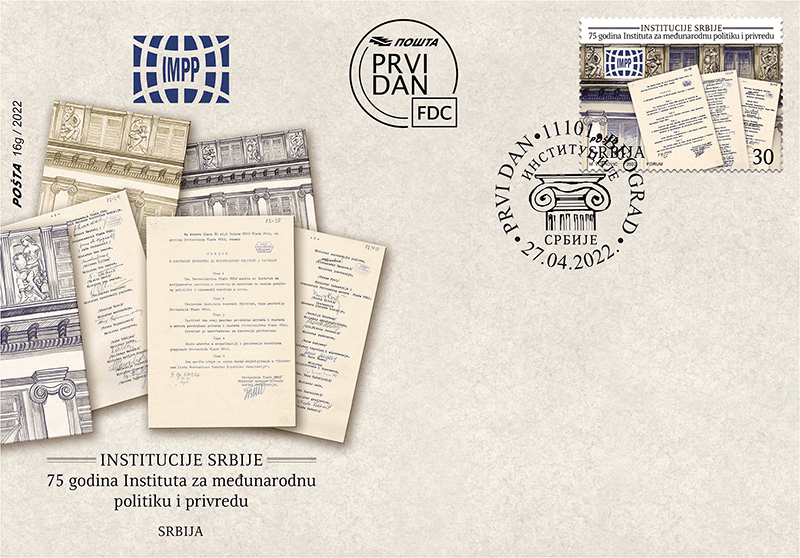

160 years of statistics in Serbia
The beginning of official statistics in Serbia is considered to be April 18, 1862, when Prince Mihailo Obrenović signed an act obliging the Economic Department of the Ministry of Finance to conduct statistical affairs for all branches of state administration. The head of the department was Prof. Vladimir Jakšić, PhD (1824–1899), who in 1850 proposed the establishment of the State Statistical Office.
The most important statistical work of that time was the State Gazette of Serbia. The development of various areas of economic and social statistics and the harmonization of the population census with international recommendations has begun. The first law on statistics was passed in 1881, and as early as 1885, Serbia was among the 23 countries from which members of the International Statistical Institute (founded in the same year) were proposed. After Jakšić retired, Bogoljub Jovanović, PhD (1839–1924) took over the management of statistics in 1888. The period of development of statistics under the leadership of Jakšić and Jovanović is considered the period of its flourishing in Serbia.
Following modern international trends and the development of new technologies, the activities of official statistics, which began 160 years ago, continue and are still developing today. Instead of the State Gazette, the Statistical Yearbook is published, printed books are replaced by electronic publications and databases, while electronic dissemination has taken the leading role in presenting the results of official statistics.
Economic Department, Statistical Department, National Statistical Administration Office, Statistical Office, Bureau of Statistics and Records, and Republic Statistical Office – are all the names of institutions that have kept official Serbian statistics for the past 160 years, produced and published reliable, accurate and comparable results, in accordance with international statistical standards.
Expert collaboration: Statistical Office of the Republic of Serbia
150 years of the Serbian Medical Association
The Serbian Medical Association was founded on May 4, 1872 in Belgrade, on the initiative of Dr Vladan Đorđević, the first Serbian educated surgeon. The founders of the Serbian Medical Association were: Aćim Medović, Jovan Mašin, Đorđe Klinkovski, Jovan Valenta, Panagiotis Papakostopoulos, Josif Holec, Bernhard Brill, Sava Petrović, Julius Lenk, Marko Polak, Vladan Đorđević, Petar Ostojić and dentist Ilija Ranimir. The first president was Dr Aćim Medović, and the secretary was Dr Vladan Đorđević.
In 1874, the society started the magazine Serbian Archives of Medicine. During the years of its existence, SMA has initiated a series of measures in the prevention of infectious diseases, and has launched an initiative to establish a Fund to support poverty-stricken doctors, their widows and orphans. The Association played a key role in the formation of the School for Midwives in 1899, and was also greatly credited for the establishment of the Ministry of Health (1918), the Medical Faculty in Belgrade (1919), the Medical Chamber and the School for Nurses (1923). Thanks to patrons and legators, the House of the Serbian Medical Association (1932) was built in 1-3 Kraljice Natalije St.
Today, SMA has over 25,000 members, and its activities are performed through 82 branches and 70 specialist sections, through the Association of Doctors of Vojvodina and the Association of Doctors of Kosovo and Metohija, as well as the Academy of Medical Sciences SMA, founded in 1976. The Association publishes professional journals: Serbian Archives of Medicine and the Dental Gazette of Serbia, and has published hundreds of monographs, collections of papers, handbooks and other publications. For more than 100 years, SMA was the only organization that provided postgraduate education to doctors and dentists, and today it is its main bearer. The Association also has a permanent museum exhibition with a large number of exhibits and a very rich library fund with professional publications
Today, the Serbian Medical Association, one of the oldest national institutions, is a dynamic and vital organization and the largest professional association in Serbia, which functions exclusively thanks to the voluntary activity of its members.
Expert collaboration: Serbian Medical Association
75 Years of the Institute for the Serbian Language of the Serbian Academy of Sciences
Институт за српски језик САНУ је централна научна установа у Србији за систематско, свестрано проучавање српског језика на плану синхроније и дијахроније и за израду капиталних лексикографских и лингвогеографских дела – речника и атласа. Основан је 15. јула 1947. године у оквиру Српске академије наука (доцније Српске академије наука и уметности), на темељима Лексикографског одсека, који је 1893. године формирала Српска краљевска академија на иницијативу академика Стојана Новаковића. Институт је преузео од Академије послове Лекси-кографског одсека на изради великог речника српског језика као један од својих најважнијих задатака.
The first director of the Institute was Academician Aleksandar Belić, the most prominent Serbian and one of the world’s leading Slavic Studies scholars in the first half of the 20th century. The future academicians Irena Grickat, Milka Ivić, Pavle Ivić and Mitar Pešikan were formed as scholars at the Institute. The mission of the Institute is achieved through six departments: Department for the Linguistic Research of the Modern Serbian Language and the Dictionary of the Serbian Academy of Sciences and Arts, Old Church Slavonic Department, Etymology Department, Dialectology Department, Standard Language Department and the Digitization Department. The Institute is involved in the development of Serbian Language Studies through the publication of linguistic journals – two co-published with the Serbian Academy of Sciences and Arts: Srpski dijalektološki zbornik, initiated by A. Belić in 1905 (68 volumes), and Južnoslovenski filolog, initiated in 1913 by A. Belić and Ljubomir Stojanović (77 volumes). In 1932, Academician A. Belić launched Naš jezik, a journal dedicated to the study of modern Serbian language and nurturing language culture (52 volumes in the new series). Since 2000, the journal Lingvističke aktuelnosti has been published online. In 1970, the Institute started a new series, Biblioteka Južnoslovenskog filologa (25 volumes). In 2004, the series Monografije was launched, where the research results of the Institute’s associates are published. Along with these publications, the Institute occasionally publishes edited volumes and takes part in co-publishing projects.
Expert collaboration: The Institute for the Serbian Language of the Serbian Academy of Sciences and Arts
75 Years of Institute of International Politics and Economics
The Institute of International Politics and Economics was established on 8 December 1947 by the Decree of the Government of the Federal People’s Republic of Yugoslavia, with the idea of providing expertise in foreign policy decision-making to the Presidency of the Government. It is one of the oldest state research institutes in the Europe exclusively dedicated to the study of international relations. The research at the Institute includes phenomena and processes in the political, security, legal and economic aspects of international relations, especially those determining the position of the Republic of Serbia in world politics and the global economy. The research is primarily aimed at finding sound policy solutions to the immediate and medium-term international challenges the domestic foreign policy-makers are facing. The Institute has been intertwined with the needs of state bodies with competencies in foreign policy and foreign economic relations of former SFR Yugoslavia, the FR Yugoslavia, the State Union of Serbia and Montenegro, and today, the Republic of Serbia. The Library and Information Centre has one of the largest libraries specialised in international relations with more than 150,000 titles, among which more than 500 books from 19th century. The role in public diplomacy has also been part of its activities including regular communication with representatives of foreign diplomatic missions and international organisations, and participation in the work of various intergovernmental fora and bodies. For outstanding achievements and contribution to the study of international relations, as well on the occasion of the 70th anniversary, Institute of International Politics and Economics was awarded the Sretenje Medal by the decree of the President of the Republic of Serbia on 9 February 2017.
Expert collaboration: The Institute of International Politics and Economics
Artistic realisation of the issue: MA Marija Vlahovic, academic graphic artist
EUROPE - Stories and Myths

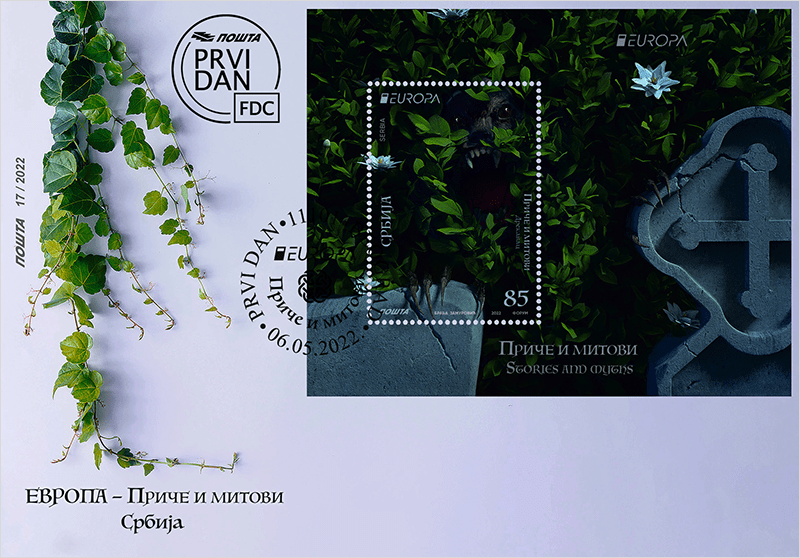

Drekavac (literally, the Shrieker) is a creature from the mythology of the South Slavs, especially represented in the mythology of the Serbs. The name of this creature comes from the verb drečati, which means to shriek or scream. Legends mention that it produces frightening cries that resemble those of children, howling wolves, bleating male goats, meowing cats or screeching birds. These cries, it is believed, can make a person deaf.
Folk beliefs also say that Drekavac is like a vampire, a material manifestation of the soul of the deceased who cannot find its peace after death, so it comes out of the grave at night and torments those who have wronged them in life. According to other legends, Drekavac is the manifest form of the soul of a dead, unbaptized child, who comes out of its grave at night and visits its parents' house.
In the description of Drekavac, it is most often mentioned that it is a demonic being, covered with long fur, which it constantly treads on and because of that he shrieks. It has large and sharp nails on its fingers, resembling claws, and it is believed that it is capable of shapeshifting.
These creatures inhabit caves, forests, ponds, rivers and willows, and can be found only at night, near cemeteries or forests. They are very afraid of daylight and dogs. They attack people who find themselves near a cemetery or forest at night, by jumping on their backs, riding them, and forcing them to run all night, until the first roosters. When the first roosters crow, Drekavac pushes its prey away by the road or the forest, and leaves it lying there.
Legends say that Drekavac is the most dangerous for people in the period of the so-called "Unbaptized days", from Orthodox Christmas to the Epiphany, when they are most often encountered.
Artistic realization of the issue: Zamurović brothers
Technical details
6. мај 2022.
Уметничка обрада браћа Замуровић
Бл.97. 85,00 дин (вишебојна) 10.000
Табак: Блок
На коверту са жигом ПД (FDC)
Нацрти: Бл. 97. Дрекавац – биће из митологије Јужних Словена.
Величина марке у блоку : 35 x 49,3 мм
Величина блока: 100 x 80 мм (обрезан)
STAMP DAY


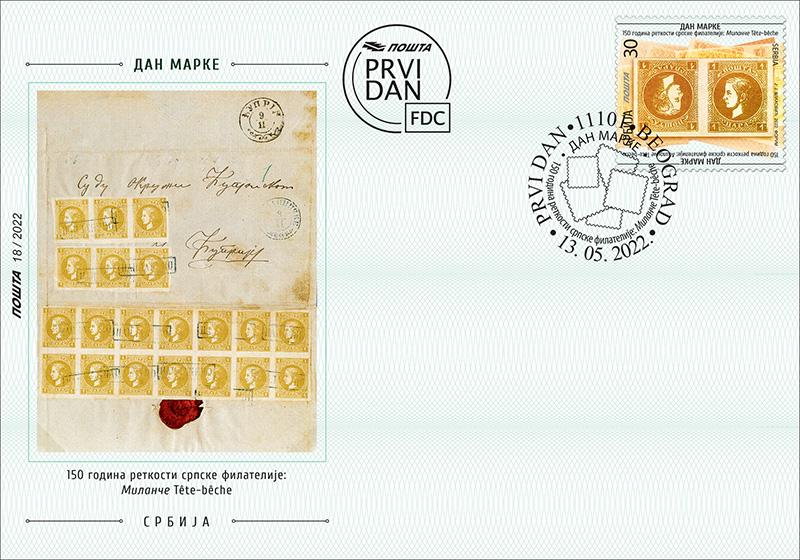

150 years of Serbian Philately Rarity: Milanče Tête-bêche
Issuance of postage stamps with the image of Prince Milan – the popular ”Milančići”, published in the period 1869/1880, certainly represent the most interesting era of Serbian philately. However, the newspaper stamp of this edition from 1872, whose nominal value is 1 Serbian penny, gave Serbian classical philately a rarity of world proportions: ”Milanče” in tête-bêche form.
The most famous Serbian philatelists, Evžen Deroko and Mirko Rašić, in their manuals, pointed out the existence of this pair in tête-bêche form. The exact circumstances that led to the formation of this pair can be speculated, but the most probable, accepted version is that this feature came about by incorrectly inserting clichés during printing. The error was soon discovered and corrected, but one copy was still preserved.
This rarity was first part of the famous Ferrary’s collection (Philipp la Renotière von Ferrary 1850–1917), which was dominated by world-class rarities. Due to the circumstances in Serbia, Ferrary almost lost his life, and later, as a sign of gratitude, he built a school building in Pirot and became a frequent guest in the kingdom and a personal friend of the King Milan. King himself has most likely gifted him with this rarity, knowing that Ferrary was a passionate philatelist. After it was sold at auction in the 1920s, nothing was known about this tête-bêche until the publication of Mirko Rašić’s book, when it was first presented to a wider audience.
The last time this Serbian rarity was sold at an auction abroad for 70,000 Swiss francs.
Motif on FDC: November 8, 1872. Block of fourteen and two strips of three of 1 para yellow, imperforated, on a cover sent from Svilajnac to Paraćin tied by boxed PAID – largest known multiple on a cover (letter from collection of Predrag Antić, Belgrade).
Expert collaboration: Vladimir Milić, MPhil, Graduate Electrical Engineer.
Graphic realization of the issue: MA Jakša Vlahović, academic graphic artist
35th Belgrade Marathon

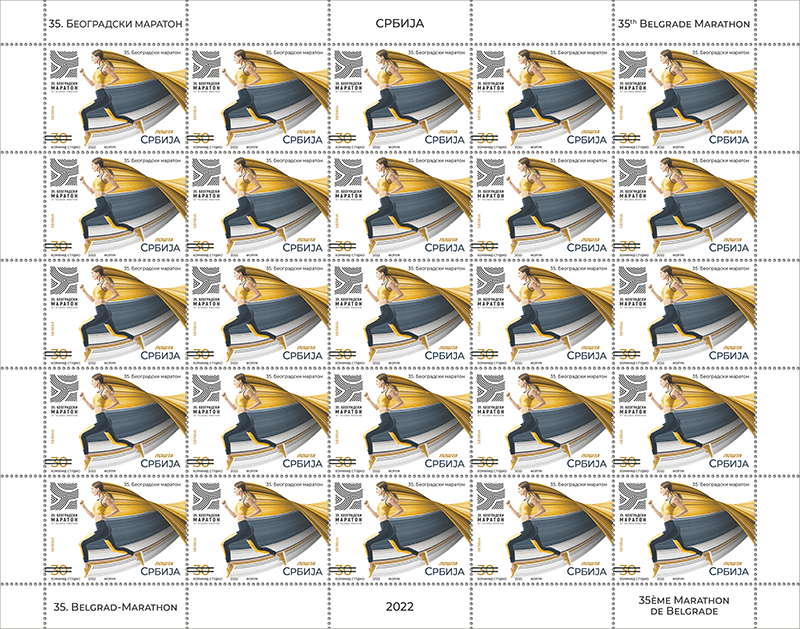


The Belgrade Marathon is the largest, most massive and most important traditional sport event in Serbia.
The jubilean, 35th Belgrade Marathon will be held on Sunday, 15 May 2022, on the International Family Day, under the slogan “Friendship in the long run”.
Like all other events organized by the Belgrade Marathon, this one will be dedicated to extremely important and current social topics such as promoting the importance of physical activity, promoting the importance of environmental protection and the importance of helping and supporting people with disabilities, and their inclusion in regular flows of recreation, sports and life.
The first Belgrade Marathon was held in May 1988, which makes it one of the oldest international sport events in Serbia.
During its 35 years of existence, the Belgrade Marathon has been realized and developed successfully, even in extraordinary and extremely complex conditions, in times of social, economic and political crises and is the only sport event (and not only sport) that has retained its international status even in times of sanctions imposed on FR Yugoslavia by the international community.
By the decision of the Assembly of the City of Belgrade from 2003, the Belgrade Marathon was declared an event of special importance for the City of Belgrade.
Based on extensive agency research, the Belgrade Marathon is the second largest event in Belgrade in terms of size, importance and popularity in general, right after the Book Fair, and ahead of all other long-standing, prestigious sport and cultural events.
The Belgrade Marathon is also a multi-award winning event by the domestic and foreign professional public. With its organization, the Belgrade Marathon today is a model for many similar events in the region.
Expert collaboration: Darko Habuš, director, Belgrade Marathon
Graphic realization: Hominid Studio
100 Years of the Rowing Club Red Star Belgrade




The Belgrade Rowing Club was founded on June 6, 1922, and on March 4, 1945, it became one of the founders of the Red Star Sports Association and has been called the Rowing Club Red Star ever since.
The Club building, one of the most beautiful buildings of this type, built in 1935, was designed by the Russian architect Valery Stashevsky, in the then wild surroundings of Ada Ciganlija. The members of the Club were many prominent Belgraders, including Andra Žeželj, Ivo Andrić, Miloš Crnjanski. The Club has been under the auspices of the Karađorđević royal family from June 8, 1922 until today. As of 2018, the Club has been organizing the Prince Stefan regatta, dedicated to Prince Stefan Karađorđević.
In addition to top results, the Club is dedicated to the popularization of rowing – it is the organizer of numerous events – Rowing for my school, in cooperation with RTS, the live broadcast of which is watched all around Serbia and the surrounding countries, New Year’s Cross, Ergonaut, etc.
It is estimated that over 20,000 people rowed for the Club, of which 3,500 represented the Club in the national teams of the Kingdom of SCS, FNRY, SFRY, FR Yugoslavia and the Republic of Serbia, at European and world championships and the Olympic Games.
In turbulent times, when state systems and borders were changing, wars and crises raging, the Rowing Club Red Star – Belgrade maintained a hundred-year continuity, managed to gather numerous members on the postulates of fair play, personal commitment, responsibility and excellence, to win numerous medals, participate in the building of our society and contribute to the growth of one hundred generations of Belgraders.
Expert collaboration: Rowing Club Red Star – Belgrade
Artistic realization of the issue: MA Nadežda Skočajić, Academic Graphic Artist
350 Years since the birth of Peter the Great





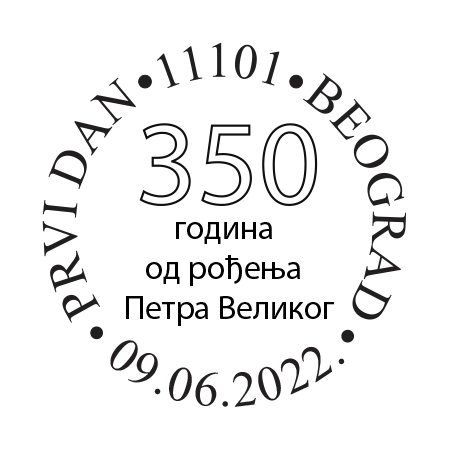
Peter I Alexeevich Romanov – Peter the Great (June 9, 1672 – St. Petersburg, February 8, 1725) Russian tsar, one of the most powerful and influential rulers of modern European history. He modernized Russia in social, political, military and economic terms, at the same time expanding its territory, thus transforming Russia into the leading European power of the time. He made radical changes in Russian society and the state. He replaced the traditional Russian calendar with the Julian one, and also built a new capital – St. Petersburg, which was founded on May 27, 1703.
Stamp motifs: portrait of Peter the Great, Boban Savić; Portrait of Emperor Peter the Great, unknown author, Hermitage, oil on canvas, 18th century.
Motif on the vignettes: Decree of Peter the Great On sending two teachers from the Holy Synod to Serbia to teach the local people Latin and Slovenian, which established the First Serbian School in Sremski Karlovci.
Motif on the envelope: footage from the comic Peter the Great; authors: Konstantin Konstantinovich Kuznetsov and Pavle Sergeyevich Polyakov; published in “Politikin zabavnik” magazine in 1941.
Artistic realization: Boban Savić, MA, academic painter
Serbian Police Day



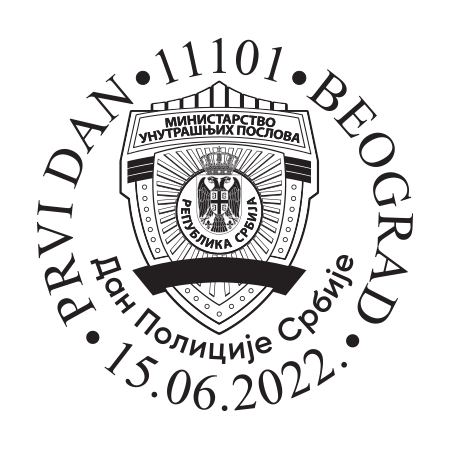
Serbian Police Day is marked in memory of 1862, when Serbian gendarmes played a crucial role in the conflicts near the Belgrade Čukur-fountain on Trinity Sunday and during the Turkish bombing of Belgrade the next day.
Officers have always been an important part of the Serbian Police.
The roots of officer and patrol activity in Serbia go back to the first half of the 19th century. The first law enforcement officers, defenders of law and justice, so-called patrolmen or quartermasters, were first established in the town police in the 1830s.
The streets of Belgrade at that time were mostly guarded by Turkish guards. Due to frequent complaints about their zeal, the chief of the Belgrade police hired a large number of Serbian cops – quartermasters, who, in a national suit, without a recog¬nizable uniform, took over patrolling the streets of Belgrade for the first time. By the decision of the first policeman of the city, and for the sake of greater security of the citizens, Belgrade also received street lighting, 10 lanterns that were distributed around the city.
In 1862, municipal night guards were formed. They were equipped with a whistle, a hand lantern and a tying rope, and three years later, with the adoption of The Rules of Night Watch, they were given a uniform for the first time.
As of 1928, the officers were ranked in classes, were given an official number on the buckle of the belt, wore a gendarmerie-like uniform, and some of them patrolled on bicycles.
Modern officer patrols were established immediately after the Second World War, in 1946. They were made up of people’s militiamen, who in 1966 received a new uni¬form, part of which was a recognizable “titovka” with a red five-pointed star, which many still remember.
The officer activity was abolished in 1991, and on the initiative of Minister Aleksandar Vulin, this year the officers were returned to our streets.
Since the appointment of Jakov Nenadović as the first minister of the internal affairs in 1811 until today, the police have undergone numerous changes, but one thing has remained the same - it is always in the service of its citizens.
Expert collaboration: Ministry of internal affairs – Jasna Popović-Ćosić; KPU – Prof. Ivana Krsić Mistridželović; Artistic realization of the issue: Nadežda Skočajić, Academic Graphic Artist
ART: Architecture Bajrakli Mosque in Belgrade



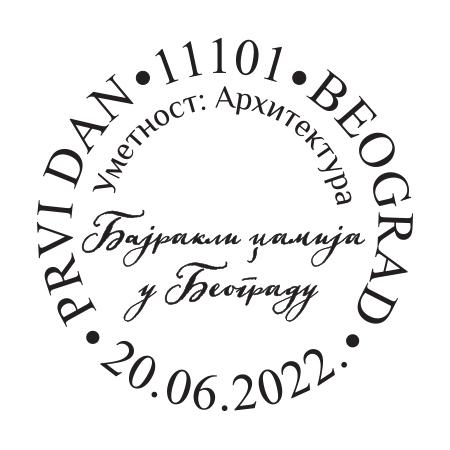
The Bajrakli Mosque, the main Islamic cultural centre in Belgrade, is a one-room building with a dome and minaret, built around 1522. It was originally called the Čohadži Mosque, after the endowment donor, the baize merchant, Hadži Alija. After the renovation in 1741, it was called Hussein-bey’s mosque for some time, and at the end of the 18th century it was named Bajrakli-mosque, after the flag that stood out on it as a sign for the simultaneous beginning of prayer in all mosques.
The architecture of the mosque belongs to the type of one-room cubic building with a square base, with an octagonal dome supported by eastern subdome arches and niches - trompes, with modest console decoration and a minaret.
It is built of stone, with massive walls with few openings. On the outer northwest side there are minarets, a narrow tower with a conical roof, with a circular terrace at the top. Opposite the entrance, inside the mosque, is the holiest space - the mihrab, a shallow niche with ornate vault decoration, set in the direction of the holy city of Mecca to the southeast. To the right of the mihrab there is a mimbar, an elevated wooden pulpit, and above the entrance is a wooden gallery - mahfil.
The interior decoration of the mosque is modest, with rare stylized floral and geometrized motifs and calligraphic inscriptions of verses from the Koran on the walls.
Due to its antiquity, rarity, preservation of its original purpose, as well as the representativeness of religious architecture and Islamic culture, the mosque was placed under state protection as a cultural monument in 1946, and in 1979 was declared a cultural asset of great importance.
Expert collaboration: Islamic religious community in Belgrade
Artistic realization of the issue: Miroslav Nikolić
European nature protection






The special nature reserve Jelašnica gorge is located in Ponišavlje and covers 115.73 ha. It stretches in the northwest–southeast direction. The gorge was formed by an intensive vertical incision of the Jelašnica river into limestone rocks, creating a narrow valley, with steep sides, about 1.5 km long. The sections of the gorge are gradually distributed and broken by water erosion into rocky capes, lonely teeth resembling structures, canvases and pillars. It is a habitat of numerous relict and endemic species. The symbols of this gorge are: Serbian ramonda (Ramonda serbica) and Nathalie’s ramonda (Ramonda nathaliae), tertiary relics of the Balkans. Together with the Sićevo gorge, it is the only locality in the Balkans where these species grow together.
Based on the Study of Protection of the Institute for Nature Conservation of Serbia, the Government of the Republic of Serbia declared the Jelašnica Gorge in 1995 as a protected area of the first category of protection, as an area of exceptional international and national importance.
Expert collaboration: Bogosav Stoiljković, Institute for Nature Conservation of Serbia
The special nature reserve Trešnjica gorge covers an area of 595.38 ha and is located in Podrinje, in the lower part of the river Drina and extends in the east-west direction. The clear mountain river Trešnjica, just before merging with the Drina, carved a limestone gorge several kilometers long.
About 500 m deep, with cliffs that rise vertically above the flow of the river, the gorge in some places takes on the characteristics of a canyon valley, especially in the area of the confluence of the Tribuća and Trešnjica rivers. Many birds of prey nest in the gorge, such as the golden eagle (Aquila chrysaetos) and the peregrine falcon (Falco peregrinus), but it is primarily recognizable by a colony of griffon vultures (Gyps fulvus) with about 45 individuals which is more and more numerous and stable thanks to the organized feeding and the work of the guard service.
Based on the Study of Protection of the Institute for Nature Conservation of Serbia, the Government of the Republic of Serbia declared the gorge of the river Trešnjica, a protected area of the first category of protection in 1993, as an area of international and national importance.
Expert collaboration: Miloš Radaković, Institute for Nature Conservation of Serbia
Artistic realization of the issue: Miroslav Nikolić
25 Years of “ Telekom Srbija” JSC




Telekom Srbija was founded at the dawn of the new technological age, in June 1997. Since then, it has witnessed and initiated technological revolutions that have completely reshaped our lives – changing our habits, the ways we do our daily jobs, the way we learn, work and have fun, always striving to provide a seamless experience of connection and communication. The company still manages to achieve this today, in the same way as when it started, by cultivating a close connection and a relationship of trust with its customers.
In the jubilee year, for the first time since its establishment, Telekom Srbija is a leader on the Serbian market in all telecommunications services, strongly positioned in this region through its subsidiaries. With bold strategic strides, the company today transcends national and regional frameworks by offering its top services and prestigious television and film content globally. Diligent work, dedication and constant learning are responsible for such a development path, from a simple landline, to a leading producer and distributor of series that are viewed on five continents.
Success only becomes complete when shared with others. That is why the company is starting to support all those who are embarking on an adventure to fulfill their ideas and desires, by launching a fund to help young technology companies, thus becoming part of new success stories.
Also, with the desire to strongly and sincerely support the community in which it operates, Telekom Srbija continually invests in healthcare, education and entrepreneurship as clear preconditions for further development of society. This is how lasting partnerships have been established. The company has always supported high art and culture, thus enabling a large number of young people to accomplish themselves in creative and noble ways. As over the last 25 years, the company remains where you are in the decades and anniversaries to come.
Expert collaboration: Telekom Srbija
Artistic realisation of the issue: MA Marija Vlahovic, academic graphic artist
60 years of diplomatic relations between Serbia and Algeria




Already in the 1950s and early 1960s, during the liberation war for Algerian independence, the Algerian-Serbian ties became numerous and rich, as evi¬denced by the correspondence exchanged between Algiers and Belgrade, as well as the visit of Ferhat Abbas, President of the Provisional Government of Algeria to Belgrade in June 1959.
Diplomatic relations were established immediately after the referendum on Algeria’s independence, which was held on July 1, 1962. The decision to open an embassy in Algeria was made by the then Yugoslav authorities on July 2, 1962, and a formal decision to establish diplomatic relations was signed on July 3, 1962.
After the establishment of diplomatic relations between the two countries, the exchange of visits of their highest statesmen followed. President Tito first visited Algiers in April 1965, and a year later, Algerian President Houari Boumediene visited Belgrade.
The driving force laid the foundations for broad bilateral cooperation, which was translated into numerous agreements in various fields, the first of which was on trade, signed in June 1963.
The two friendly countries continue to work on intensifying and revitalizing bilateral cooperation and expanding it in areas of common interest between the two friendly nations. The commemorative issue on the occasion of 60 years of diplomatic relations between Serbia and Algeria is a contribution of the Post of Serbia to the continuous development, improvement and deepen¬ing of relations between the two countries.
Motif of the stamp: Šišatovac Monastery, Serbia and the Grand Mosque of Algiers, Algeria.
Motifs on vignettes: detail (fresco) from the window of the monastery Šišatovac; plums and dates, characteristic fruits of Serbia and Algeria; mosaic fountain in the Casbah of Algiers.
Motif on FDC: Smederevo Fortress, Serbia and the Casbah of Algiers, Algeria.
Expert collaboration: Embassy of the People’s Democratic Republic of Algeria
Artistic realization of the issue: Miroslav Nikolić
Prominent Serbs

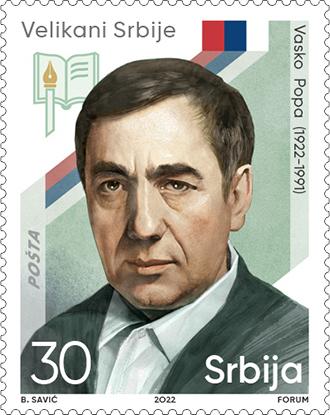




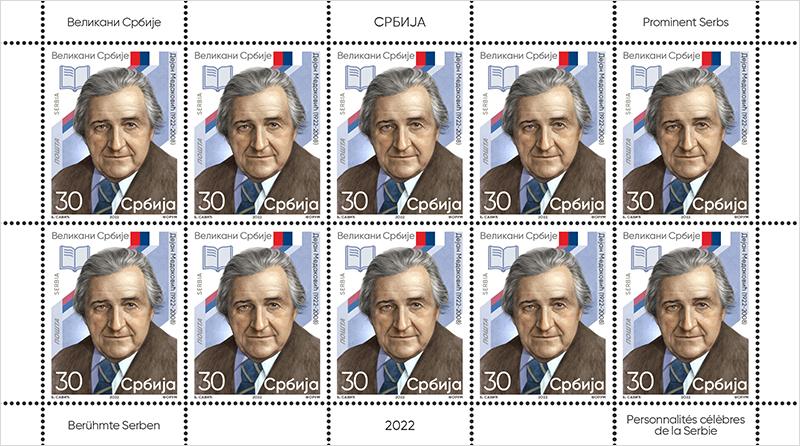


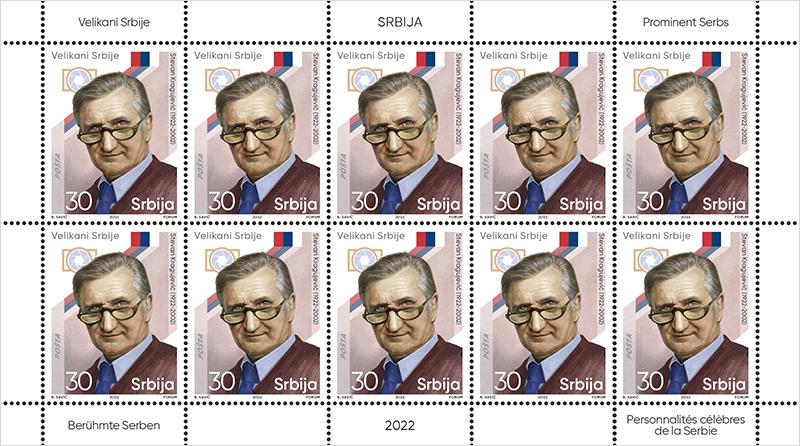




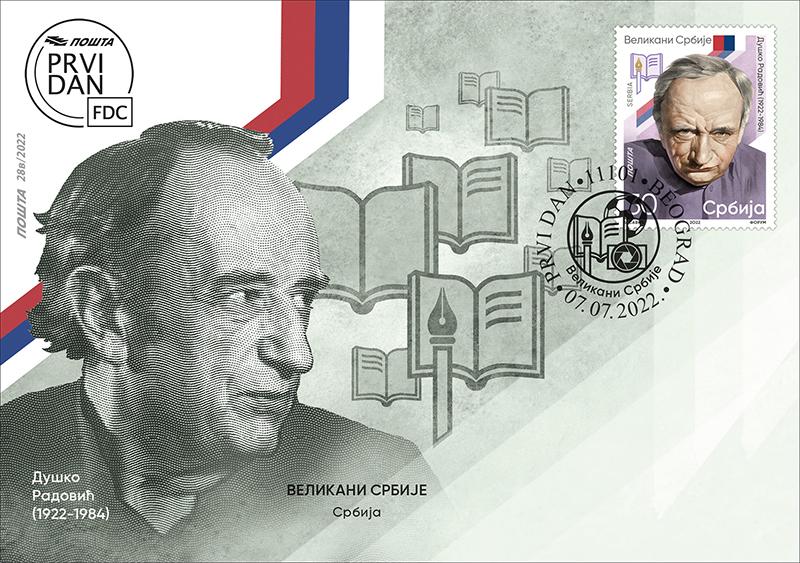




Dejan Medaković (Zagreb, July 7, 1922 – Belgrade, July 1, 2008), academic and president of SASA, art historian, poet and writer, was born on July 7, 1922 in Zagreb. He finished grammar school in Sremski Karlovci in 1941. During the Second World War, he lived in Belgrade, where he worked as an assistant volunteer at the Prince Paul Museum.
He graduated from the Faculty of Philosophy of the University of Belgrade in the group for art history in 1949. He obtained his doctorate at the Serbian Academy of Sciences in 1954 with the dissertation ”Graphics of Serbian printed books of the 15th–17th century”. Immediately after that, he was elected an assistant at the Faculty of Philosophy in Belgrade, where he acquired all the teaching titles, and he was even the dean of this faculty from 1971 to 1973. He was elected a corresponding member of SASA in 1972, and a regular member in 1981. As one of the most accomplished Serbian intellectuals of his time, an erudite who grew up at the Academy performing numerous functions, he reached the peak of his life and scientific career by being elected president of the Serbian Academy of Sciences and Arts in 1999.
Numerous awards and recognitions, together with his epochal works, best depict the rich work of academic Dejan Medaković, which left a deep mark in Serbian science and culture. He died on July 1, 2008 in Belgrade.
Vasko Popa (Grebenac, June 29, 1922 – Belgrade, January 5, 1991), Serbian poet and academic, is one of the most translated of our poets, the founder of post-war modern poetry, who was also a translator for French.
Romanian by his ethnic background, he completed his elementary and secondary education in Vršac and enrolled at the Faculty of Philosophy in Belgrade. He continued his studies in Bucharest and Vienna, and during the Second World War he was imprisoned in the German concentration camp in Zrenjanin. After the end of the war, he graduated from the Romance group of the Faculty of Philosophy in Belgrade in 1949.
He published his first poems in the newspapers ”Književne novine” and ”Borba”. His first collection of poems ”Bark” (1953), along with ”87 poems” by Miodrag Pavlović, is considered the beginning of Serbian post-war modern poetry. That book initiated discussions among the literary public and had a significant impact on later generations of poets. After the Bark, Popa published collections of poems: ”No-Rest field” (1956), ”Secondary Heaven” (1968), ”Earth Erect” (1972), ”Wolf Salt” (1975), ”Home in the Middle of the Road” (1975), ”Raw Meat” (1975), ”Cut” (1981) as well as the cycle of poems ”The Little Box” (1984), part of the future collection ”Iron Plantation”, which he never completed.
From 1954 to 1979, he worked as an editor at the Nolit publishing house in Belgrade. He prepared collections: ”The Golden Apple” (Belgrade, 1958), ”Pealing Man” (Belgrade, 1960), ”Midnight Sun” (Belgrade, 1962). In Vršac, on May 29, 1972, he founded the Literary Municipality of Vršac (KOV) and started an unusual library on postcards, called ”Free Leaves”. In the same year, he was elected a corresponding member of the Serbian Academy of Sciences and Arts. He is one of the founders of the Vojvodina Academy of Sciences and Arts (December 14, 1979) in Novi Sad. He died in Belgrade on January 5, 1991.
Duško Radović (Niš, November 29, 1922 – Belgrade, August 16, 1984) was a Serbian poet, writer, journalist, aphorist and TV editor. He was the editor-in-chief of ”Pionirske novine”, editor of the Children's Program of Radio Belgrade, editor of the Children's Program of Television Belgrade, screenwriter and songwriter for the popular children's television series ”Na slovo na slovo”, editor of ”Poletarac”, journalist of ”Borba” and since 1975 editor of Studio B.
His show ”Good Morning Belgrade” began airing on Studio B in July 1975, and was cancelled in 1982, when certain officials of the ruling Communist League described Duško's aphorisms as ”political messages with a pronounced moralistic and demagogic background. ”
He is the author of collections of songs for children ”Dear children”, ”Funny words”, ”Where is the land of Dembelija”, and generations of children grew up with his songs performed by the children's choir ”Hummingbirds”, including Blue Rabbit, Scary Lion, Toast (Everything that grows would like to grow). He is also the author of the children's radio drama ”Captain John Peoplefox”, ”How Ugly Words Came to Be”, ”Stories for Gordana”, and it was noted that, as a member of the editorial board and translator, he gave names to characters in the famous comic book Lucky Luke.
He died on August 16, 1984 in Belgrade. The widest audience remembers him for the aphorisms with which he woke up the people of Belgrade on the airwaves of Radio Studio B, which were later published in three books ”Good Morning Belgrade”.
He was a big fan of soccer and a fan of FC Partizan.
Stevan Kragujević (Senta, February 4, 1922 – Belgrade, April 17, 2002), was one of the most important Yugoslav and Serbian photo reporters and photo artists. He started with photography at the age of fourteen, and it was noted that he was the author of the first colour cover page in post-war Yugoslavia (the front page of the magazine ”Duga”, number 313 from 1950). Namely, the colour photograph of ”Guščarica”, a young woman with a basket and geese in the Vojvodina alley, made by Kragujević in 1943, was published on the cover of the magazine ”Duga”, which became our first illustrated magazine with a colour cover.
As the first photo reporter of the Directorate for Information under the Presidency of the SFRY, he made, among other things, the first official portrait of President Tito, in 1950, intended for foreign embassies and correspondents. In his later career, Kragujević made a rich fund of recordings of President Tito, following his travels in the country and abroad, meetings with foreign statesmen, workers, artists, citizens, but, in addition to official photographs, he also made anthological, unofficial recordings. From 1951 to 1953, he was a member of the Tanjug photojournalist team, and from 1953 until his retirement in 1982, he was a photojournalist and photography editor of the daily ”Politika”.
During his work in ”Politika”, he performed other important jobs - he was the head of the photo laboratory and photo service of this house, and until his retirement, as a photo editor, he significantly contributed to the introduction of new sections in ”Politika”, especially those that emphasized the full value and importance of photography (”In pictures and words”).
The rich photo-documentary endowment, the legacy of Stevan Kragujević, is in the Museum of Yugoslavia, the Society Adligat and the Historical Archive of Senta.
Borislav Mihajlović Mihiz (Irig, October 17, 1922 – Belgrade, December 15, 1997) was a Serbian literary critic, writer, script editor, screenwriter, essayist, travel writer, poet, playwright and polemicist.
He finished the classical grammar school in Sremski Karlovci, and after the war he enrolled at the Faculty of Philosophy, a group for Serbo-Croatian language and literature in Belgrade.
From 1951 to 1954, he worked as a literary critic for NIN, but due to his association with the then unsuitable Milovan Đilas, he was forced to leave this job. He was then the manager of the Matica Srpska Library, the artistic director of Avala Film, the editor of the publishing company Prosveta, and together with Mira Trailović he created the Atelier 212 theatre and was its artistic advisor from 1971 to 1983.
He has collaborated with the following newspapers and magazines: NIN, Politika, Književne novine, Književna reč, Dnevnik, Zagreb's Vjesnik, Ljubljana's Delo, Vienna's Die Presse, Duga, etc.; in the journals Letopis Matice srpske, Književnost, Savremenik, Delo and many others in which he published articles, essays, reviews, travelogues, feuilletons, and interviews. He wrote poems, literary criticism, essays, travelogues, polemics, and plays. Several dramatizations of famous literary works came out of his pen.
He is the holder of many literary awards: the Sterija Award and the ”Marin Držić” Award of the Association of Dramatic Artists of Yugoslavia for the drama ”Banović Strahinja”; Sterija's awards for dramatization of Nušić's ”Autobiography”, Sterija's awards for adaptation of Pekić's ”Correspondence”; awards of the Library ”Đorđe Jovanović” for the book of criticism ”Portraits”, awards of Miloš Crnjanski for the first book ”Autobiography – on others”, etc. Belgrade theatres, as well as many other stages across the country, performed Mihiz's plays, and Matica Srpska has been publishing the collected works of Borislav Mihajlović Mihiz since 2021.
Rajko Mitić (Dol, November 19, 1922 – Belgrade, March 29, 2008), football player and sports journalist, first Red Star captain and first Red Star star. He started his career before 1940 in Belgrade's BSK, and after the war he started playing for Red Star, where he became famous. He played in the position of the right half. He made his debut for the Yugoslav national team in the first interstate match after the Second World War, on May 9, 1946 against Czechoslovakia (2: 0) in Prague. During 11 years of playing for the national team of Yugoslavia, he played 59 times for the best selection and scored 32 goals. He participated in the World Cups in Brazil in 1950 and in Switzerland in 1954. Due to his correct game, he was remembered as a great gentleman of football.
The Second World War stopped his sports development, but from 1944, as a fighter of the NOVJ engineering brigade (together with Đajić and Jezerkić), he continued to play, and since the founding of the Red Star on March 4, 1945, he was its first captain. Since then, he has worn the ”red and white” jersey in 14 championship seasons as one of the best players in the history of the Red Star. He played a total of 572 games (of which 220 championships and 39 in the Cup) and scored 116 goals (74 championships and 22 in the Cup).
When he stopped playing, from 1960 to 1966, as a senior sports coach, he was the head of the Red Star's professional staff, and as an active player he was a commentator for Belgrade's ”Sport”, and later devoted himself completely to sports journalism as a long time commentator in the newspaper ”Tempo”.
Artistic realization: Boban Savić, MA, academic painter
Air Serbia – 95 years




This year marks the 95th anniversary of the founding of the first airline in Serbia. Founded under the name Aeroput, on June 17, 1927, today it operates under the globally known name Air Serbia.
The first domestic airline, Aeroput, operated until 1947, when it was succeeded by Yugoslav Air Transport (JAT), which was transformed into Jat Airways in 2003, while the new chapter of the company, now called Air Serbia, began in 2013.
Employees of today’s Air Serbia are extremely proud of the fact that only a few airlines in the world have a history as long as the Serbian airline, which is on the eighth place on the list of the oldest airlines in the world that still operate.
Under the slogan ”95 years of flying”, Air Serbia pays tribute to the rich history of the Serbian national airline, and a special emblem marking this anniversary, designed to combine tradition and modern moment, will be clearly displayed on the body of 12 Airbus planes and five planes type ATR.
In addition to creating and implementing a special emblem on its aircraft, Air Serbia will mark its 95th anniversary on June 17 with a series of commemorative activities.
Expert collaboration and design: Air Serbia
Graphic realization of the issue: Studio Srbijamarka
Dragan Džajić – brand for the whole world




Dragan Džajić (Ub, May 30, 1946), soccer player, sports official and the third star of Zvezda, is considered the best Yugoslav soccer player of all time. He started his career in 1962 in Crvena Zvezda (Red Star), for which he played until 1978, with the exception of two seasons he spent in Bastia (France). As a player, manager and president, he won a record 31 trophies at Red Star: 16 national championship titles, 12 national cup winners' trophies, the European Champions Cup and the Intercontinental Cup, as well as the Central European Cup.
He played 590 games for Red Star and scored 287 goals. He played for the Yugoslav national team 85 times and scored 23 times. He played for the world selection, in 1968 he took third place in the selection for Ballon d’Or (the Golden Ball), and in the same year he won a silver medal at the Cup of Nations of Europe, where Yugoslavia was defeated by Italy in the repeated match of the final. In the semi-final match of the same competition, Džajić scored a spectacular goal against the world champions, England – he tricked Wilson on the run, brought captain Moore to his knees in the penalty area and then lobbed goalkeeper Banks. He participated in the World Championship in 1974 in Germany. In 1969, he was chosen as the best sportsman of Yugoslavia in the "Sport" newspaper's selection.
Since 1979, he held a number of positions as a manager at the Red Star. As the sports director of the club, he selected the team that in 1991 achieved the greatest club success in the history of Serbian football by winning the European Champions Cup, with a victory over Olympique de Marseille, after a better penalty kick performance. In the same year, Red Star also won the Intercontinental Cup in Tokyo, with a triumph over the Kolo Kolo team from Chile.
Džajić served as the president of Red Star from 1998 to 2002, as well as from 2012 to 2014. In the history of soccer, he will be remembered as one of the best left wings in European soccer. Today, he is the honorary president of the Red Star soccer club.
Expert collaboration: FC Crvena Zvezda/Red Star Graphic design: Nadežda Skočajić, Academic Graphic Artist
Serbia – Italy: The 100th lap in Monza



Serbia and Italy are connected by many cultural and economic ties, and many occasions confirmed the friendship of the two countries throughout the rich history of bilateral relations at different levels. The issue of the postage stamp “Serbia – Italy: The 100th Lap in Monza” celebrates one hundred years since the construction of the Monza Race Track, the first motor racing track in Europe and the third in the world. An important jubilee of the Italian motor sports and the opportunity to underline the relevance of the cultural and sports ties that connect the two countries. The Monza Race Track with its history and its iconic circuit hosts still today some of the most exiting car races. The “Temple of Speed” has won a place in the collective imagination, inspiring motor sport's lovers and the cult Serbian movie “The 100th lap in Monza”.
Artistic realization of the issue: Boban Savić MA, academic painter
100 years of the Academic Theatre AKUD of the University of Belgrade “Branko Krsmanović”




After the First World War, in addition to the professional National Theatre in Belgrade, there were also several dilettante theatre groups whose actors were high school and university students. The repertoire of these groups consisted mainly of comedies with which they toured the entire country. A group of students from Belgrade University, including Mata Milošević, Milan Dedinac, Aleksandar Janković, Milenko Živković, Draga Novaković, Dragomir Plaović and Svetozar Popović, met in the restaurant of the Moskva Hotel on September 15, 1922 and decided to found an academic theatre under the auspices of the University.
At that time, the Art Theatre from Moscow was visiting Belgrade, so the director Yuri Rakitin, who had previously worked at the National Theatre, was asked by academics to do the first performance in the new, Academic Theatre. Rakitin agreed, and rehearsals for Chekhov’s “The Seagull” began immediately, which had its premiere on April 3, 1923, in the hall of the former Manjež. One of the leading roles, Treplev, was played by Mata Milošević. The academic theatre, with short interruptions, also worked during the Second World War, and immediately after the liberation, it continued its work within the framework of the “Branko Krsmanović” Academic Cultural and Art Society, under the auspices of the University of Belgrade.
That’s how it all started and continues for a hundred years.
Expert collaboration: AKUD “Branko Krsmanović”
Artistic realization of the issue: Boban Savić MA, academic painter
25 Years of Diplomatic Relations Between Republic of Serbia and Republic of Azerbaijan



Republic of Azerbaijan and Republic of Serbia have established diplomatic relations 25 years ago, in 1997. Ever since, Serbia and Azerbaijan have nurtured intensive and outstanding bilateral relations, which are continually improved to mutual satisfaction. The issue of commemorative postal stamps “25 Years of Diplomatic Relations Between Republic of Serbia and Republic of Azerbaijan” reflects extraordinary relations between the two friendly countries, but also contributes to their further advancement. The symbolism of paired architectural achievements of the two countries in the area of spirituality, culture and economy, which characterises this issue, highlights the important fields of cooperation between the two countries, but also the common shared values which put the successful economy in the foreground, at the same time relying on spirituality and culture as sources and guarantees of preservation and permanent building of the national identity.
The Republic of Azerbaijan was the first democratic and secular republic in the Islamic world. It was founded in 1918, and as soon as 1920 it became a part of the Soviet Union. After 71 years of existence within the USSR, Azerbaijan restored its independence. The establishment of diplomatic relations between Serbia and Azerbaijan in 1997 reflected the friendly relations that existed between the two nations in the previous period and the will to further improve these relations. First of all, the two friendly countries are developing economic and cultural cooperation, but their cooperation and mutual assistance in the international organisations are of great importance as well. Now the bilateral relations of Serbia and Azerbaijan have reached the level of the strategic partnership based on the shared values, most importantly respect of the principles of international law, especially the respect of the territorial integrity of the states.
Expert cooperation: Embassy of the Republic of Azerbaijan in Belgrade
Artistic realization of the issue: Miroslav Nikolić
140 Years since the Establishment of Diplomatic Relations between the Republic of Serbia and the Republic of Portugal
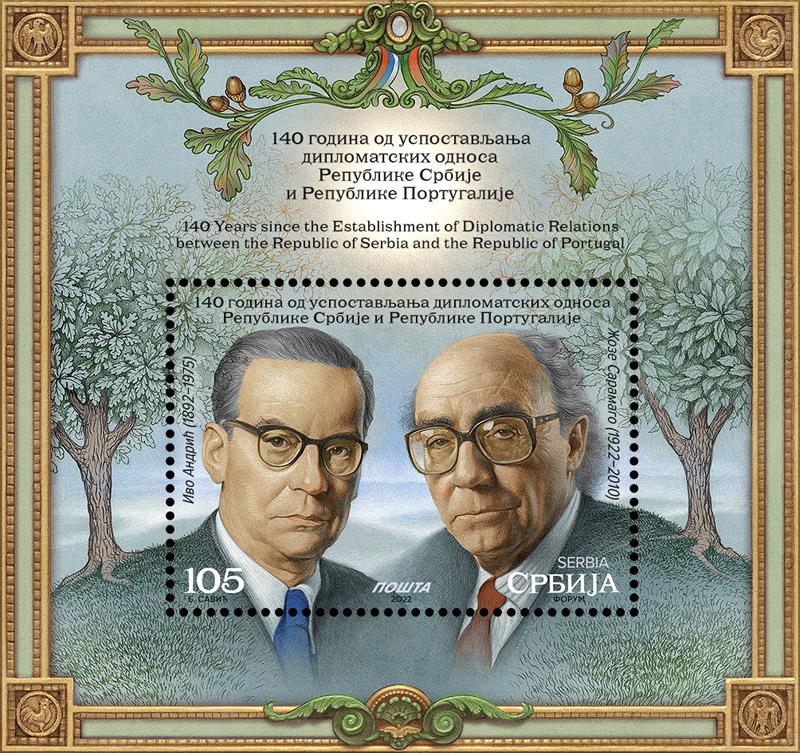


The long history of diplomatic relations between Serbia and Portugal and the desire to intensify cooperation in all areas characterise the traditionally good and friendly relations between the Republic of Serbia and the Republic of Portugal.
Portugal provides strong support to Serbia’s progress towards EU membership and the integration of the Western Balkan region, and frequent diplomatic activities in recent years lead to further improvement of relations between the two countries and an increase in bilateral economic activities and the level of trade through the intensification of economic contacts.
Although small, the Serbian community in Portugal contributes to the quality of cultural exchange between the two countries and to the intensification of cultural cooperation, which overall makes Serbia and Portugal foster excellent political and diplomatic relations and sincere friendship between the two peoples.
The symbolism represented in the issue 140 Years since the Establishment of Diplomatic Relations between Serbia and Portugal reflects important segments of the relations between Portugal and Serbia. The cultures that connect the two peoples are best represented by important writers José Saramago and Ivo Andrić, who are also Nobel Prize winners for literature and internationally the most expressive representatives of the cultural and literary milieu of their nations. The same national tree – oak, along with the features of the species that grows both in Portugal and Serbia, illustrates the sameness of ideas and values that are most often associated with this tree, but also the uniqueness of the national identities of Portugal and Serbia. Finally, the architectural accomplishments that symbolise the capitals of Belgrade and Lisbon – the buildings of the national parliaments, besides the artistic value, also carry the ideological one, above all the commitment of both peoples to the ideals of democracy.
Expert collaboration: Embassy of the Republic of Portugal in Belgrade
Artistic realization of the issue: Boban Savić MA, academic painter
85 Years of Diplomatic Relations between Serbia and Iran



Relations between Tehran and Belgrade existed for many years before the establishment of official diplomatic relations between the two countries. The Government of the Kingdom of Persia, in a note dated 11 September, 1919, through the Embassy of the Kingdom of Serbs, Croats and Slovenes in the capital of Romania, reported that it recognised the Kingdom of Serbs, Croats and Slovenes, the state whose unification was proclaimed on 1 December, 1918.
Formal diplomatic relations between the two countries were established in 1937 with the opening of embassies in Tehran and Belgrade. Since then, until today, the Republic of Serbia and the Islamic Republic of Iran have traditionally had good relations characterised by regular meetings of officials and mutual support in international organisations. Numerous visits, conversations and meetings of the highest political and economic delegations of the two countries in the fields of economic, technical, cultural, educational and sports cooperation ensure the priority interests of the two countries.
Expert collaboration: Embassy of the Islamic Republic of Iran in Belgrade
Artistic realization of the issue: Miroslav Nikolić
Joy of Europe




On the occasion of World Children’s Day, the first international festival of children songs and dances “Joy of Europe”, supported by the authorities of the City of Belgrade, President Tito, UNICEF and the General Assembly of the United Nations, was held in 1969 in Belgrade. More than half a century passed and over 20,000 children have visited Belgrade. From the beginning, the hosts have been the main pillar of the manifestation – parents who receive boys and girls of Europe in their homes, showing our traditional hospitality.
The basic idea of the manifestation was and still is getting to know each other and making friends, while the children’s play is in the centre of all the events.
The International Fine Art Competition “Joy of Europe” is the youngest programme entity of the Manifestation, and, since its founding, it has been gathering for the twenty-fourth time children and young art creators (4 to 18 years) from around the world, through their rich fine art creativity. Traditionally, the works selected by a jury of experts are presented on a commemorative postal stamp “Joy of Europe”. The best sign of authenticity of children’s creativity is the fine-art play and enjoyment in the very act of creativity.
This year’s selection of works for the postal stamp, vignette and envelope represents the miraculous power of imagination, powerful enough to paint out the dark side of reality and open innumerable opportunities which are offered to children and the young in their creative leisure time. A postal stamp like this gives the most beautiful support to the natural and creative way of living because the children’s fine art creativity bears in itself unrepeatable authenticity, power and freshness!
Motif on the stamp: drawing by Nebojša Jovčić (11 years, Serbia). The authors of drawings on vignettes are: Ema Hricová (8 years, Slovakia), Ivana Španović (6 years, Serbia), Tijana Dobrašinović (11 years, Serbia), Kira Chochieva (9 years, Russsia), Júlia Stajnová (9 years, Serbia), Stefan Krstevski (13 years, North Macedonia), Laura Grulová (8 years, Slovakia) Motif on the envelope: drawing by Foo Yee Ching Stephanie (7 years, China)
Expert collaboration: Lidija Seničar, editor of the International Fine-Art Competition “Joy of Europe”, Children’s cultural centre Belgrade
Graphic realisation of the issue: MA Jakša Vlahović, academic graphic artist
Classics of World Literature Leo Tolstoy (1828−1910)
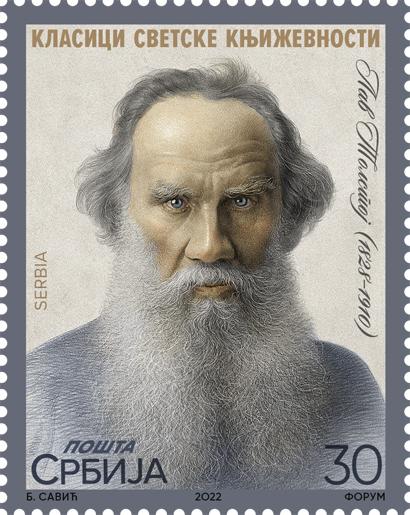




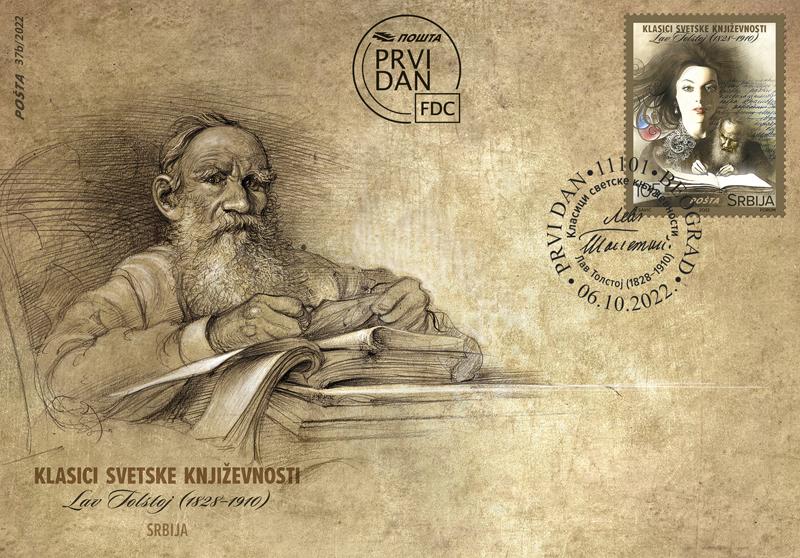



145 years ago, one of the most valuable and significant works of world literature saw the light of day – Tolstoy's novel “Anna Karenina”, a work that has special significance for Serbia and the Serbian people.
Leo Nikolayevich Tolstoy (Yasnaya Polyana, September 9, 1828 – Astapovo, November 20, 1910) is one of the greatest Russian and world writers. Through his magnificent novels, he described the Russian society of his time, simultaneously painting a fantastic picture of human characters and human nature, thus becoming part of the corpus of world classics of timeless value. In addition to his timeless literary legacy, Tolstoy was also known for his pedagogical work, which had a significant impact on later pedagogical concepts. In 1859, he opened the first school in Russia for the children of peasants and serfs in his house in Yasnaya Polyana. Tolstoy devoted his entire literary and pedagogical work to unravelling the difficult social situation in Russia and efforts to show that the solution to the problem lies exclusively in a peaceful path and through pedagogic and educational work.
Serbia and the novel "Anna Karenina" are linked by history – on August 20, 1876, Nikolay Raevsky, the future prototype of the character of Count Vronsky, was killed in a battle against the Turks. In 1903, the church of the Holy Trinity was built at the place where the Russian hero was killed in the village of Gornji Adrovac, which today the Serbian people call the Russian Church or the Church of Count Vronsky.
The issue of commemorative postage stamps marking an important historical and literary event, the first publication of the novel “Anna Karenina”, especially emphasizes the bond between the Serbian and Russian people expressed through the characters and events of this monumental work of world literature.
Expert collaboration: Russian Centre of Science and Culture “The Russian House” in Belgrade.
Artistic realization of the issue: Boban Savić MA, academic painter
WORLD POST DAY




All the national postal administrations commemorate the World Post Day on 9 October, the day of foundation of the Universal Postal Union in 1874 in Berne. The Kingdom of Serbia was one of the twenty-two founding countries present at the Founding Congress. The resolution on commemorating the day of the global postal community which today gathers 192 countries was passed in 1969 at the Congress of the Universal Postal Union in Tokyo.
The main objective of marking the World Post Day is raising the awareness about the importance and significance of the role of the Post as institution and the influence it makes on the daily life of people worldwide, on its support to global business, as well as about the contribution the Post provides to the total universal social and economic development of the humankind.
The slogan under which the World Post Day is celebrated this year is Post for the Planet. Postal sector, as a global player in the sector of delivery of goods and services should, with its activities on mitigation of the climate changes, take the leading role and show the way to its partners in the universal chain of supply. The struggle against climate changes is not easy, because the global progress, social and economic development of the human civilisation depend on the results of this struggle. The task of the Post as institution and global economic subject is to ensure, by its activities on the business plan, sustainable development and better future for generations to come.
Expert collaboration: Universal Postal Union
Museum Exibits
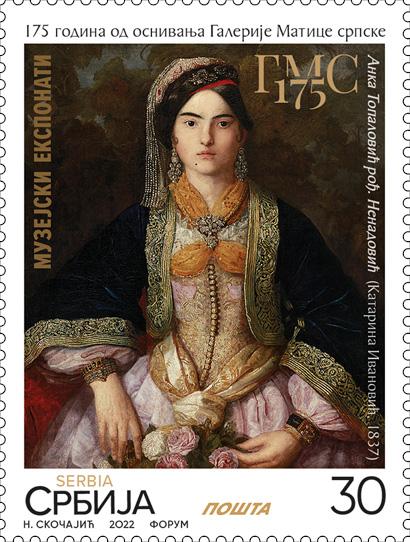









175 Years of the Founding of The Gallery of Matica Srpska
The Gallery of Matica Srpska, as the oldest national art museum, is, as it were, a mirror of the state, a sort of stain glass window depicting historic events, showcasing artistic preferences and aspirations of Serbian artists. Likewise, the Gallery protects the memory of its funding members, directors, art collectors, researchers, artists, and particularly that of its benefactors who have inscribed their names in the history-book of the Gallery and Serbian culture in general.
As it was created during the past 175 years, the history of the collection of the Gallery of Matica Srpska is the history of the Serbian people, art, and culture, which reflects all socio-historical, cultural, and artistic changes that Serbian society underwent in a wider geographical area – from the former Austrian and Ottoman Empires, through various forms of state organization of the former Yugoslavia, to the present Republic of Serbia. The collection, primarily oriented towards painting, numbers 10,000 works of art. It is divided into 16 collections and includes outstanding examples of graphics, sculpture, drawings, applied art which highlight the origin, development and achievements of Serbian art and indicate the origins, position and the place of Serbian culture and art in European context.
Our contribution to the culture of remembrance is manifested in our professional approach to the care for the protection of artworks, as well as in the realization of numerous exhibitions and programmes for the audience, especially educational projects for children and young people.
The Gallery of Matica Srpska strives to be the place that acts in the contemporary moment while the sense of belonging to the nation is enhanced by the feelings of respect and pride.
By respecting tradition, we create tradition.
Motif on the stamp: Anka Topalović née Nenadović, (Katarina Ivanović, 1837). Motif on the envelope: The Proclamation of Dušan’s Code (Pavle Paja Jovanović, around 1930)
Expert collaboration: The Gallery of Matica Srpska
175 Years of the Founding of the Museum of Vojvodina
The roots of the Museum of Vojvodina reach back to 1847, when Matica srpska, then located in Pest, decided to establish the Serbian National Collection or Museum. The first museum collection was created from the legacy of Sava Tekelija, and was presented only after the opening of the Museum of Matica Srpska in 1933. After the Second World War, part of the material was separated from here and by the decision of the provincial authorities on May 30, 1947, the Vojvodina Museum was established as a museum of a complex type, the largest of its kind in Serbia, with collections ranging from archaeology, ethnology, history, art history to zoology, botany, geology, palaeontology and mineralogy.
From the funds of the Vojvodina Museum, many institutions in the sphere of cultural and nature protection branched out: Museum of the Labour Movement and National Revolution of Vojvodina, the Museum of the City of Novi Sad, the Theatre Museum of Vojvodina, the Institute for the Protection of Cultural Monuments and the Institute for Nature Protection. The Historical Museum of Vojvodina, founded in 1956 under the name of the Museum of the Labour Movement and National Revolution, merged with the Vojvodina Museum in 1992 to form an institution called the Museum of Vojvodina.
Today, it is a modern institution with a rich collection of around 200,000 items and a specialized library, which has regularly published the annual publication “Work of the Museum of Vojvodina” since 1952. It has five permanent exhibitions and five depandans, among which are ethno park “Brvnara” in Bački Jark, Museum Complex in Kulpin and Medical Museum Collection - Pasteur Institute. The main activity of the Museum of Vojvodina is the collection, processing, protection, documentation, presentation and publication of movable cultural assets, as well as supervision of the professional work of 16 museums, galleries and museum collections in the area of Vojvodina.
Motif on the stamp: Roman gilded helmet (4th century AD). Motif on the envelope: Museum of Vojvodina bulding (Bogumil Karlavaris)
Expert collaboration: Museum of Vojvodina, Novi Sad
75 years since the founding of the Institute of Archaeology
The Institute of Archaeology was founded in 1947 in Belgrade with Professor Vladimir Petkovic appointed as its first Administrator. One of the goals that was set after its formation was the definition of work plans in which the focus was placed on the study of the development process of human civilization based on archaeological material in the territory of Serbia and in its surroundings. From its foundation until today, the institution has carried out a series of large-scale researches of archaeological sites of various forms and scopes, as well as performed the protection of material cultural assets. Numerous localities that are chronologically defined from prehistory, antiquity and the Middle Ages, up to the Turkish period were the subject of systematic field work by the Institute´s scientific associates. One of the primary missions of the Institute of Archaeology is the development of social sciences and humanities, with the main focus on defining the past, publishing scientific results, and popularizing cultural heritage. The work of the Institute in recent times is particularly characterized by fruitful cooperation with institutions and colleagues from the country and abroad, which is reflected through the introduction and application of modern scientific methods in research practice. By studying the material remains with the implementation of modern scientific approaches, results are obtained that allow us to more clearly reconstruct the way of life, culture, art and the scope of human mind in Serbia over the centuries, which today represents the most important scientific activity of the Institute of Archaeology in Belgrade.
Expert collaboration: Institute of Archaeology, Belgrade
Graphic realization of the issue: Nadežda Skočajić, academic graphic designer
105 years of diplomatic relations between the Republic of Serbia and the Kingdom of Denmark




Serbia and Denmark established diplomatic relations on October 19th, 1917. Dr. Milutin Jovanović, at the height of the First World War, submits a letter of credence to the Danish court. The issuing of the commemorative postage stamp for 105 years of diplomatic relations between the Republic of Serbia and the Kingdom of Denmark marks an anniversary, a testimony to the significance and lastingness of ties between the two countries.
In spite of being located at two opposite ends of Europe, contact between Serbia and Denmark had existed long before there was discourse concerning diplomatic relations, most notably in the field of culture. Several curated collections of Serbian folk songs were translated into Danish in the 19th century. Hans Christian Andersen portrayed Serbia and the Serbian people in a dedicated chapter titled Dryads of Serbia in his A Poet’s Bazaar travelogue from 1842. Upon returning from their voyage to the Scandinavian country, two prominent Serbian scientists and politicians Milenko Vesnić and Svetomir Nikolajević introduced the Danes’ culture and art to the Serbian public through their articles. Since 1901. Copenhagen has been a home to the Serbian street.
The commemorative postage stamp represents King Petar I Karađorđević and King Christian X since the diplomatic relations between Kingdom of Serbia and Kingdom of Denmark were established during their reigns. The photographs of the kings are a part of a Kingdom of Serbia and Kingdom of Denmark collection of documents published by the State Archives of Serbia. The book was issued for the occasion of the 105th anniversary of Serbian-Danish diplomatic relations and edited by Dr. Jasmina Mitrović-Marić, Ambassador of the Republic of Serbia in Copenhagen, Jelica Reljić and Aleksandar Marković.
Celebrating this diplomatic anniversary, in addition to preserving the memory of substantive bilateral relations, contributes to their improvement and longevity.
Expert coollaboration: The State Archives of Serbia
Artistic realisation of the issue: MA Marija Vlahovic, academic graphic artist
Serbia – Angola 100 years since the birth of Agostinho Neto



Antonio Agostinho Neto (port. António Agostinho Neto; Katete, 17 September, 1922 – Moscow, 10 September, 1979), poet and national leader, founder of the left-hand People’s Movement for the Liberation of Angola in 1953 and one of the leaders of the struggle for Angola’s independence, was the first president of the independent Angola (1975–1979).
He studied medicine in Lisbon, and in the 1940s became an important element in the movement that sought to return to traditional Angolan culture. Upon his return to Angola, he was arrested for his opposition to colonialism, so he fled to Morocco and became the leader of the Angolan resistance movement in exile.
Agostinho Neto was arrested in 1960 and taken to Cape Verde and later to Lisbon. After some time, due to great public pressure, he was released under house arrest, but managed to escape to Morocco, and from there to Zaire.
After the overthrow of the dictatorship in Portugal in 1974, the independence movement strengthened in Angola, and on 11 November, 1975, after 56 years of struggle, Angola was officially declared independent, and Agostinho Neto became its first president. His government established close ties with socialist countries. Angola established particularly good relations with our country, and the close friendship between Angola and Serbia, which continues to this day, began in this period.
Neto died on 10 September, 1979, during chirurgical intervention in Moscow, while civil war was raging in his homeland. Today, the day of his birth is celebrated in Angola as a holiday, the Day of National Heroes, and the University of Luanda bears his name.
Expert collaboration: Embassy of the Republic of Angola to Serbia
Artistic realization of the issue: Boban Savić MA, academic painter
85 years of the Belgrade Fair




When, on 6 June, 1937, on the left bank of the Sava river, on the marshland right next to the newly built King Alexander Bridge that connected Belgrade and Zemun, the foundation stone for the fair exhibition area, known today as the Old Fairground, was laid, few expected that already in the autumn of the same year, the first exhibition would be held there on an area of 17,000 square meters in 26 pavilions of different purposes. The Autumn Fair, officially opened on 11 September, 1937, was the first official manifestation of the Belgrade Fair. In March 1938, the first Belgrade Car Show was organized, the oldest fair manifestation that is still held today.
In the years before the Second World War, exhibitions and manifestations, domestic and international, took place. In addition to exhibitions, cultural manifestations were also organized at the fair, and the fair became a place that the citizens of Belgrade liked to visit. The autumn fair of 1938 brought together 910 exhibitors, among others the company “Philips”, which installed an internal television at the fair whose programme visitors could follow on TVs in the pavilions.
The Second World War interrupted the activities of the Belgrade Fair, and the area of the fair was turned into a concentration camp where a great pogrom of Jews was carried out.
Twenty years after the first opening, the Belgrade Fair was opened for the second time, on 23 August, 1957, when the Technical Fair was opened, in the newly built area on the left bank of the Sava, where it is still located today. That year, the Technical Fair was visited by more than a million people, and the following year, in 1958, at the same event, TV Belgrade broadcast its first show from a studio located at the Belgrade Fair.
The Belgrade Fair is one of the three world fairs located on the river bank, and its circular Hall 1, with a 109-metre span dome, built of prestressed concrete, has been declared a monument of culture.
Expert collaboration: Belgrade fair Artistic realization of the issue: Miroslav Nikolić
50 years of diplomatic relations between the Republic of Serbia and the People’s Republic of Bangladesh




Shortly after Bangladesh gained independence in 1971, on February 22, 1972, diplomatic relations were established between the then SFRY and the People’s Republic of Bangladesh, which were based from the very beginning on understanding, mutual friendship and cooperation established primarily through the Non-Aligned Movement.
Relations between our country and one of the most densely populated countries in the world, Bangladesh, are characterized by the existence of significant space for intensifying political dialogue and improving cooperation in areas of mutual interest for the two friendly states.
In the current geopolitical moment, the historical legacy in relations between Serbia and Bangladesh, which includes 50 years of bilateral cooperation, represents a good basis for even stronger and more successful cooperation between the two countries in the future. The intensification of high diplomatic contacts is a clear indicator of the will and readiness of both parties to further encourage and strengthen the political, economic and social cooperation between Serbia and Bangladesh.
Expert collaboration: Ministry of Foreign Affairs of the Republic of Serbia.
Artistic realization: Boban Savić, MA, academic painter
90th Anniversary of the Hotels Association of Serbia (HORES)




The first organized activity of business entities in the field of tourism, restaurant and hotel management dates back to 1932, when the first Association of Belgrade hoteliers, restaurateurs, innkeepers, cafe owners, owners of boarding houses and inns was founded, whose continuity is kept today by the Business Association of the Hotel and Restaurant Industry HORES.
HORES is the leading business network in the field of hotels and restaurants in the Republic of Serbia. It represents a modern business association, based on the voluntary gathering of subjects of the hotel and restaurant industry, educational institutions that train staff for this activity and other subjects who have an interest in association for the purpose of improving and developing this activity, protecting guilds, ethics, more effective promotion and increasing the competitiveness of members of the association on the tourist market.
Today, HORES has in its composition more than 400 companies that influence the creation of the tourism product of Serbia – 168 hotels and other accommodation facilities, more than 220 restaurants and other catering facilities for the provision of food and beverage services, three high school and three higher education institutions that train staff for the hospitality industry, as well as important suppliers of the hospitality and tourism industry with equipment, furniture, drinks and small inventory.
HORES is the largest and most important professional association of the restaurant industry in the country, a partner of the public sector and other social partners in creating a general business environment, economic and legal framework for business and development. The association has been a member of the International Association of Hoteliers and Restaurateurs IHRA since 2007 and the European Association of Hotels, Restaurants and Cafes HOTREC since October 2019.
Expert collaboration: Business Association of Hotel and Restaurant Industry HORES Artistic realization of the issue: Miroslav Nikolić
Five years of Government Data Center

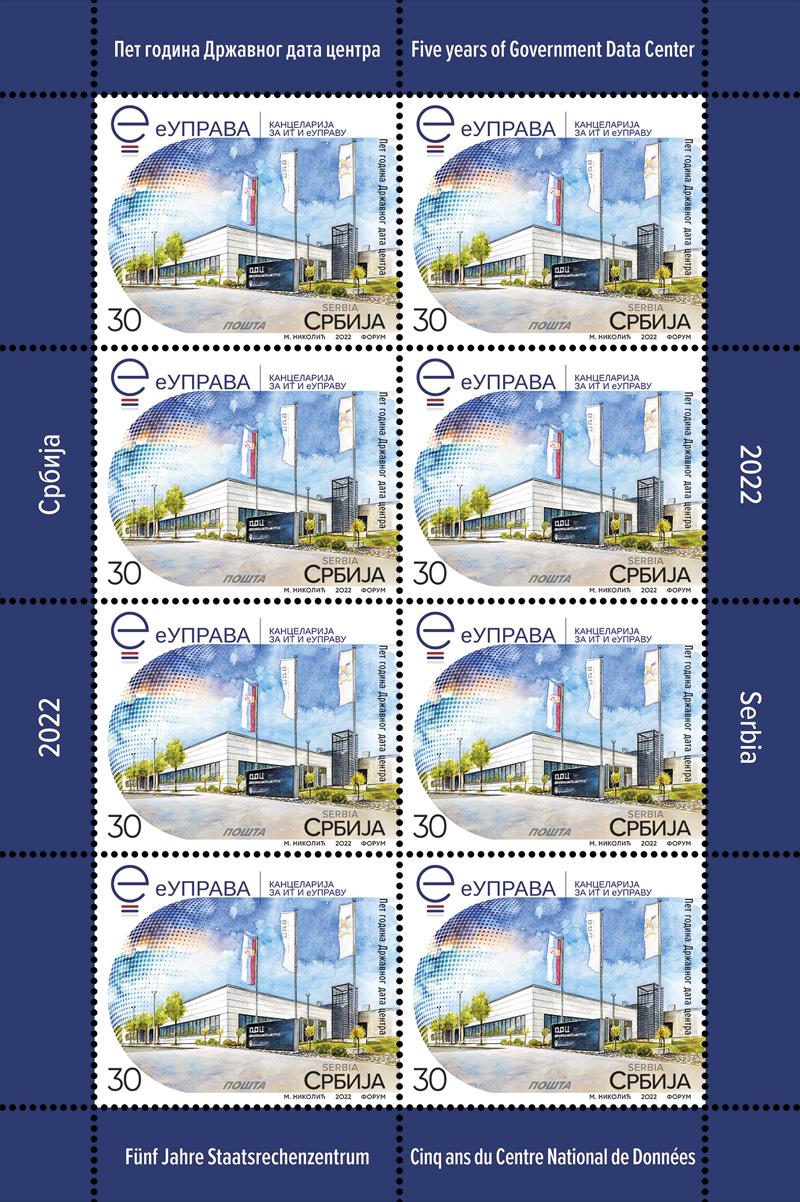

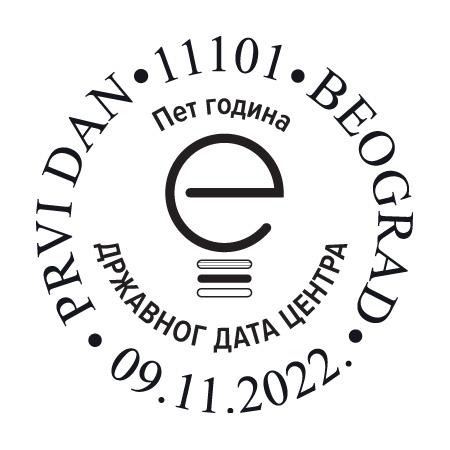
In the last five years, the Office for IT and eGovernment has opened the Government Data Center in Belgrade and two facilities of the Government Data Center in Kragujevac. Government Data Centers are the foundation of a safe, modern, efficient and transparent state. They enabled the digital transformation of Serbia›s public administration into an efficient service for citizens and businesses and the establishment of the most developed eGovernment in the region. The state authorities of the Republic of Serbia, as well as the world›s largest IT companies, entrust their data and applications to these facilities, as the most modern and safest data storage centers in this part of Europe.
Thanks to the Government Data Centers, citizens can access their data from state records at any time on the eGovernment Portal, and instead of collecting documents themselves from counter to counter, civil servants now exchange them automatically in electronic form. Government Data Centers have enabled the development and provision of all eServices in the last five years, including the services «Baby, welcome to the world», eKindergarten, eEnrollment, My High School, eMailbox, electronic signature in the cloud etc, thus contributing to the recognition and trust of citizens in eGovernment.
Expert collaboration: Office for Information Technologies and eGovernment
Artistic realization of the issue: Miroslav Nikolić
80 years of the daily newspaper “Dnevnik”




On November 15, 2022, the newspaper “Dnevnik” celebrates its 80th anniversary. In the midst of great suffering in the Second World War, exactly on that day eighty years ago, in the base under the streets of Novi Sad, the first issue of “Slobodna Vojvodina”, the forerunner of our newspaper saw the light of day.
The first issue of “Slobodna Vojvodina” was published at a time when Vojvodina was occupied, oppressed and divided, and the whole of Europe enslaved. Svetozar Marković Toza, the first editor, paid with his life for fighting the occupier with the written word. The fascists executed him, and after the liberation he was declared a national hero.
The only and at the same time the oldest daily newspaper in the Serbian language in Vojvodina, got its current name on January 1, 1953. The readers then chose the name “Dnevnik” but also decided that, as it is today, the paper should be printed in Cyrillic and with blue letterhead. For 80 years, the newspaper “Dnevnik” has preserved the Serbian language and the Cyrillic alphabet in northern Serbia, in Vojvodina.
“Dnevnik” has always been a treasure trove of excellent journalists, including academics, writers, and scientific workers. Many who mastered the journalistic craft in “Dnevnik” incorporated their knowledge in other media, printed and electronic. Ever since it was created as a spark in an enslaved country, and even today, the newspaper “Dnevnik” fosters tolerance and justice in multi-ethnic Vojvodina, informing daily about all current events, with the stamp of the climate in which we live, modernizing, but also preserving the journalistic profession through all the difficult times the country was going through. Today, “new battles” are being waged with numerous daily newspapers and media, in which “Dnevnik” bravely participates, fighting for its piece of media space, while preserving the tradition, conceived way back in 1942.
Expert collaboration: “Dnevnik”, Novi Sad
Drawing on the stamp: Miroslav Nikolić
Graphic realization of the issue: MA Jakša Vlahović, academic graphic artist
Qatar 2022



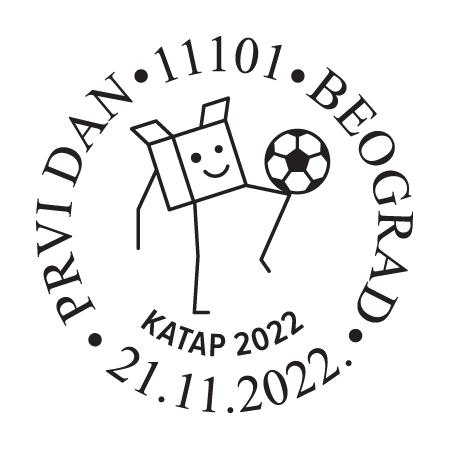
The beginning of the twenty-second competition of the best football teams in the world is approaching. For the first time in football history, a country from the Middle East was chosen as the host of this competition. The decision to hold the competition for the best football players in the world in 2022 in Qatar was made on December 2, 2010, so this year, for the first time, the ball will be rolling at the most prestigious football competition in the winter months.
The tournament starts on November 20 and will last for almost a month, and we will have the opportunity to find out who will be the winner on December 18, Qatar National Day, when the grand final is scheduled. The 32 competing national teams will play a total of 64 games in eight stadiums, spread over five host cities.
Our best team, led by Coach Dragan Stojković, will play its first match against Brazil on November 24. The whole nation is waiting with joy and impatience for the start of the big competition and hopes for the best possible news from Mitrović, Vlahović and other teammates. The Post of Serbia, together with its employees and customers, is wholeheartedly with our Eagles. Together we expect victory every time!
Artistic realization: Ivana Zotović
Slava – Celebration of Family Saint Patron’s Day




Saint Cyril and Methodius
Patron saint’s day (slava, baptismal name) is a holiday dedicated to a Christian saint when the family takes him/her as their patron and protector. The veneration of the holy protector among Serbs dates back to the time of Saint Sava. Today, the majority of the Orthodox in the territory of Serbia celebrate slava as an important holiday in which individual families and their guests – members of the extended family, spiritual relatives, neighbours and friends participate. As bearers of a unique Orthodox tradition, Serbs perceive slava as a way of expressing Christian and national identity.
It is customary for the family to go to church on the day of slava, where the bearer of the celebration - the candle holder, usually the head of the house or heir, lights the slava candle in the presence of the priest, who offers prayers for the health and blessing of the home. The Our Father prayer is recited, the troparion is sung to the saint and the slava cake is cut, which must have the symbol IС ХС НI KA (“Jesus Christ is victorious”) imprinted on it. The priest lifts the cake saying the words: “In the glory and honour of the Holy...”, cuts the cake in the shape of a cross and pours wine over the cut place. Then the cake is turned and broken into four parts while the priest congratulates the candle holder with the words: “Christ intercedes for us”, and the candle holder replies: “He does and He will!”
An important part of the celebration of the Patron Saint is the festive meal - a festive lunch where the whole family, its spiritual and blood relatives and friends gather.
Slava is a vital element of the intangible cultural heritage of the Serbian people, and in 2014 it was inscribed on the UNESCO Representative List of the Intangible Cultural Heritage of Humanity.
In the 9th century, Cyril and Methodius, brothers from Thessaloniki, popularly known as the Holy Brothers, created the Glagolitic alphabet, the first script of the Slavs. By spreading Christianity and literacy among the Slavs, the brothers helped the cultural progress of the Slavic tribes, which is why history remembers them as “Slavic apostles”. The educational work of the Holy Brothers was continued by their disciples after their death. The Orthodox Church celebrates Saint Cyril and Methodius on 24 May, and the Republic of Serbia marks this date as the Day of Slavic Literacy and Culture, which is also celebrated in other Slavic countries.
Artistic realisation of the issue: MA Marija Vlahović, academic graphic artist.
75 years of statehood of the Republic of India

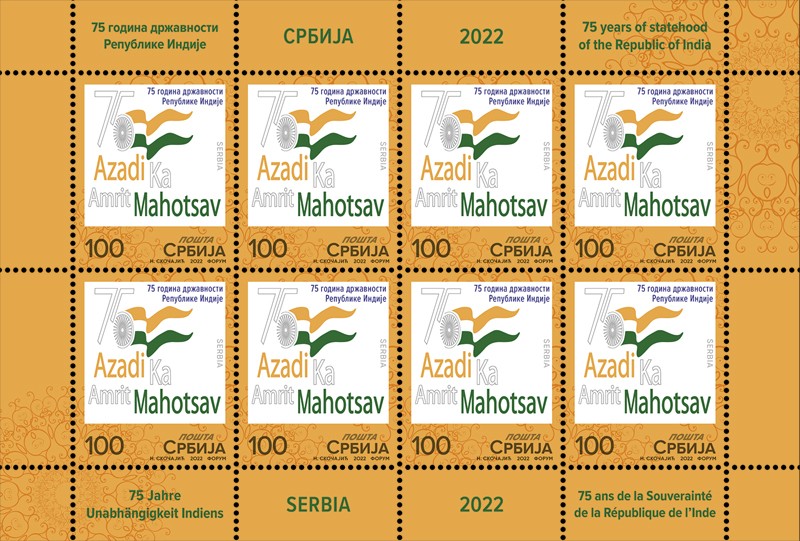


India, the world´s most populous democracy, is marking 75 years of independence this year, celebrating the extraordinary history of its people, culture and civilizational achievements.
This commemorative issue is being published to mark the 75th anniversary of India´s independence and freedom, whose non-violent struggle for freedom inspired numerous movements for liberation from colonialism and apartheid around the world. With unusual, powerful and unprecedented political instruments of non-violent protests, the people of India succeeded in overthrowing the British colonial rule and declaring their country´s independence on August 15, 1947.
In the decades that followed after gaining independence, India was an active participant and one of the founders of the Non-Aligned Movement, promoting the ideas of freedom, independence and peaceful coexistence among the nations and states of the world.
Since gaining independence until today, India has grown into one of the world´s leading economies, and numerous achievements in the most diverse fields of human activity, such as agriculture, industry, science and technology, have been truly inspiring for many nations of the world.
Serbia and India are bound by historical friendship, and the peoples of the two countries have great respect for each other. Bilateral relations between the two countries have been significantly improved in recent years, so the commemorative issue in honour of the 75th anniversary of India´s independence is also a tribute to the struggle of the Indian people for freedom and confirmation of the friendship between the Indian and Serbian people.
Expert collaboration: Embassy of India in Belgrade
Artistic realization: Nadežda Skočajić, Academic Graphic Artist
120 years of diplomatic relations between the Republic of Serbia and the Republic of Cuba




This year marks the 120th anniversary of the establishment of diplomatic relations between Serbia and Cuba. Upon a joint review of diplomatic archives of both Serbia and Cuba, it has been determined that the two countries initiated their diplomatic relations on 4 November 1902, by the correspondence between Aleksandar Obrenović, the then King of Serbia and Tomás Estrada Palma, the President of Cuba.
The Cuban struggle for independence from the colonial rule began in 1868 and lasted three decades. In 1902 the neocolonial republic was established and the diplomatic relations between Serbia and Cuba started that very year.
Today, Serbia and Cuba are friendly countries with long tradition of intensive bilateral relations, founded on mutual understanding and true brotherhood of the two nations. Cooperation in economy and culture has always been fruitful and it has intensified through time. The cooperation of the two countries in diplomacy has been strengthened especially through joint activities and participation in the Non-Aligned Movement, both at the time of foundation and the greatest rise of this organisation.
Cultural liaisons between the Serbian and Cuban peoples have special significance, making a sound ground for all the other forms of cooperation. The pillars of these liaisons stand in almost any area of artistic expression, especially in their common passion for contemporary music and cinematography, but also for the traditional canon in poetic and literary creation.
The issue of commemorative postal stamps “120 Years of Diplomatic Relations between of Serbia and Cuba” pays tribute by its visual contents to the two literary giants and national heroes of Cuba and Serbia, who lived and created approximately at the same time and who are linked by versatile interests and activities, outside the literary world - José Martí and Laza Kostić.
Expert collaboration: Embassy of the Republic of Cuba in Belgrade
Artistic realization: Boban Savić, MA, academic painter
65 years of diplomatic relations between the Republic of Serbia and the Republic of Tunisia




This issue of commemorative postage stamps marks 65 years of diplomatic relations between the Republic of Serbia and the Republic of Tunisia. Although official diplomatic relations between our country and the Republic of Tunisia were established in 1957, our people and the people of Tunisia have a long tradition of friendly relations and providing assistance to each other in the most difficult historical moments.
The help of the people of Tunisia to our people in the First World War will never be forgotten. During 1915 and 1916, Tunisia received a large number of Serbian soldiers who were retreating before the Austro-Hungarian offensive. Over 60,000 of our soldiers passed through the Tunisian Lazuaz camp, and from 1915 to 1919, more than 40,000 Serbian soldiers were treated in Tunisian hospitals.
The largest Serbian cemeteries in Tunisia are located in Bizerte and Menzel Bourguiba. The Christian cemetery in Bizerte preserves the remains of our deceased warriors in a memorial ossuary.
Tunisia gained its independence from colonial rule in 1956, and already in 1957, the Republic of Tunisia was proclaimed, with Habib Bourguiba elected as its first president. In the same year, our country established official diplomatic relations with the Republic of Tunisia, and in 1965, the President of the Republic of Tunisia, Habib Bourguiba, became an honorary citizen of Belgrade. The intensive cooperation between the two countries, conceived 65 years ago, nurtured through the Non-Aligned Movement, is the result of the sincere friendship of the two peoples, and in the year when we mark the 65th anniversary of the establishment of official diplomatic relations, the two countries continue on the path of improving cooperation, further intensifying political dialogue and intensifying economic and cultural exchanges.
Motif on the envelope: Sarrath river dam in Tunisa, being consturcted by a Serbian company.
Artistic realization of the issue: Miroslav Nikolić.
Serbia – United Kingdom Centenary of the BBC



The BBC (British Broadcasting Corporation), one of the largest global broadcasters of radio and television programme, started operations on 18th October 1922. It was founded under the name British Broadcasting Company, and in 1927, it received a Royal Charter and was renamed into The British Broadcasting Corporation. The BBC broadcast radio programme from the beginning, and in 1932 it started to broadcast as the first public broadcasting service.
Ever since its foundation, this corporation has played a significant role in life of the citizens of the United Kingdom. BBC programmes are watched and listened by almost the entire British population, while two-thirds of grown-ups regularly follow its radio programme. The Weakest link, Muzzy in Gondoland, Blackadder are just some of the most popular BBC programmes that have become part of global popular culture.
Famous for its high-standard news programme, excellent documentaries, legendary series and remarkable drama programmes, this media institution not only presents the authentic culture of the British Isles, but also provides insight into how the British see the world around them. During the Second World War, the Yugoslav BBC service, known as Radio London, was the most trusted source of information in occupied Yugoslavia.
Prominent Serbian writer Borislav Pekić had a show on BBC radio from 1985. Broadcast every other Sunday the contents of this show have been published as a book ‘’Letters From Abroad’’. British writer George Orwell was himself a presenter on the BBC radio in the period 1941-1943, becoming a well-known voice, representing the struggle against fascism, for many listeners worldwide. Both of them took part in the programmes while the BBC was based in the Bush House, the famous building used as the BBC headquarters from 1941 to 2021.
Today the BBC employs approximately 22.000 people, and the BBC World Service broadcasts TV, radio and online programmes in more than 40 languages - including Serbian, which started again in March of 2018.
Artistic realization of the issue: Boban Savić MA, academic painter
140 years of diplomatic relations between the Republic of Serbia and the Republic of Guatemala




During the 19th century, at a time when the young Serbian constitutional monarchy, the Principality of Serbia, was making great strides towards its complete independence from the Ottoman Empire, the country in Central America, between the Pacific Ocean and the Caribbean Sea, Guatemala was fighting its own battles for independence from colonialism. The outcome of turbulent events on European soil and the South American continent during the nineteenth century, the general civilizational progress of mankind, progress in the economy, culture, education, resulted in the creation of new states in Europe and South America. Guatemala became an independent state in 1839, and diplomatic relations between the two countries were established in 1882.
Since then, Serbia and Guatemala have fostered friendly and fraternal relations, through constant improvement of cooperation in areas of common interest, such as culture, education, sports, economy and strengthening of political dialogue and multilateral cooperation. The Republic of Guatemala provides principled support to the territorial integrity and sovereignty of Serbia.
Serbia and Guatemala are truly friendly countries whose friendly relations at a very high level, with full mutual understanding, appreciation and support in the most important issues for the two nations, have lasted for 140 years.
Artistic realization of the issue: Miroslav Nikolić
Christmas



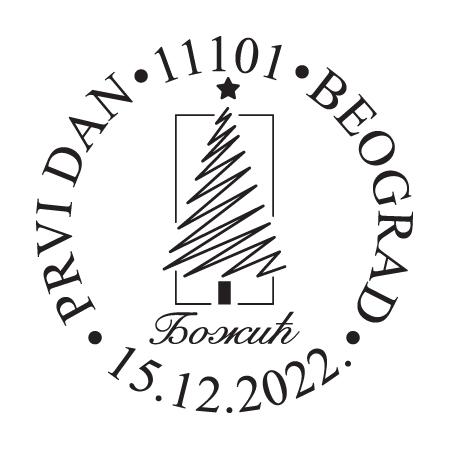
Winter Fairy Tale
Christmas is one of the most significant and joyous Christian holidays, a common holiday of all Orthodox and Catholic believers. The difference is only in the date when it is celebrated. Catholics celebrate it on December 25 and Orthodox Christians on January 7, but its message is one and the same - a message of peace and love, a message of joy and togetherness in well-spent holidays.
This year, for the first time in Belgrade, we will enjoy the pleasures of Christmas and New Year holidays together at the most beautiful holiday festival called the Winter Fairy Tale, which is organized from December 15 to January 15 in the Sava Park at the Belgrade Waterfront.
Christmas is primarily a family holiday, and there are many customs related to it. On the day before Christmas, Christmas Eve, a Badnjak - Christmas tree or branch made of oak wood is brought into the house. Badnjak is a symbol of the longevity and durability of Christianity. On Christmas Day itself, early in the morning, church bells ring and announce the birth of Christ, and everyone greets each other with the words: “Christ has been born! He has truly been born!”
To these beautiful customs, this year we can add, or revive again, one more custom, which is congratulating the holiday by writing a letter. Writing and sending letters can be an art form where each element brings a new opportunity to send love and attention to your loved ones. From the selection of paper that will absorb all your best wishes and most beautiful words, to the selection of the envelope that will store and transfer them, to the postage stamp that will mark and colour it all.
Whether you are addressing a letter to a family member or a friend, the magic of letter writing cannot be replaced by sending digital messages. Therefore, this year we want to encourage you to share the Winter Fairy Tale with those who are not physically close and remember how it used to be, when we used to send love in writing, because - Magic is here... to be shared and exchanged!
Artistic realisation of the issue: Stars and more



